Making the Most of Malta
This small island nation offers big experiences to crew
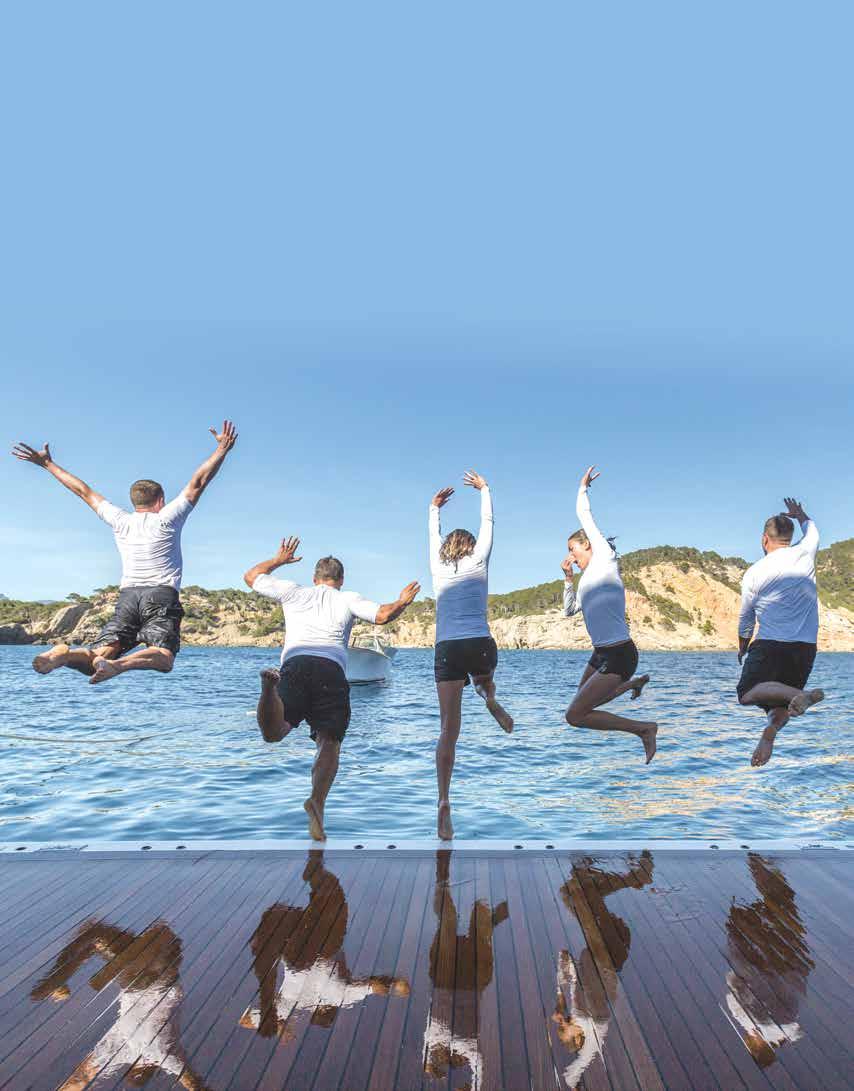
INK INCLUSION
Are tattoos accepted in yachting?
CV and Contract Tips
Onboarding for success

This small island nation offers big experiences to crew

Are tattoos accepted in yachting?
CV and Contract Tips
Onboarding for success
From tips on landing your first job to offboarding gracefully, Triton’s got you covered through every phase.

























THE FORMULA FLEET is your move forward to the ultimate Formula lifestyle! The decision is made easy whether it’s a versatile Crossover, Bowrider, Sun Sport or Center Console – extraordinary times are certain to be ahead. The Formula fleet combines all the features you like best in a clever design that’s as practical as it is beautiful – double and triple helm seating, wraparound lounges, entertainment wetbar, convertible aft sun lounges and a larger swim platform – all confirm Formula’s position at the forefront of marine design.
Select your favorite options or design your ultimate, personalized dream boat with FormulaFlex™ to tailor graphics, upholstery and electronics to your liking. When you order your Formula you have the opportunity to work with our sales team and project engineer directly or visit our head-quarters for a truly immersive experience as you make your vision a reality. Enjoy receiving photos as your personalized dream boat advances through production, plus a complete set of photos at delivery. Want a more involved view? Arrange for a tour and personally observe your boat’s progress – we would love to host you.
With FormulaFlex ™ , accent colors are interchangeable, rewarding those with creative imagination and a perceptive eye. MyWay ™ upgrades put you further in the designer’s seat with the full range of Pantone® and automotive colors at your fingertips.
Your dream Formula is closer – and easier – than you ever imagined. Let your designer eye shine in a boat built just for you, taking you to adventures you create! Your one-ofa-kind Formula is what sets you apart and makes your boating even more satisfying.


If you’re not growing, you’re shrinking

Superyachts 20 years ago are not the same today. What was large and high tech then is nothing like what a superyacht is today. Staying still is the same as falling behind, and no one wants to fall behind — especially on their yacht! The same applies in life. Whether as a professional or as a business, growth is a survival skill. No matter where you are in your career or business, you must stay relevant and competitive and grow.
At Triton, we feel the same way. Since we acquired Triton a few years ago, we were, and still are, fully committed to evolve, improve, grow, and stay relevant to the yacht crew industry. The tools that made Triton relevant when it started in 2004 were the right tools for the right target at the right time, but the toolbox is always growing, and we are shifting with it. Yachting has become more sophisticated, crew more knowledgeable, content more widely available, and technology has taken over.
So how does that constant sea change affect Triton? We stand on three primary pillars. Produce the best bi-monthly print publication for the yacht crew industry. Produce and deliver a continuous array of digital content on multiple platforms. Produce and promote yacht crew networking events throughout the year.
Those pillars will always remain, but now with our partners YATCO and ACREW, we plan to add more collaboration to those pillars. We will evolve more internationally with content, distribution, and networking events. We will expand our digital presence. We will add various membership programs for our supporters and followers. We will stay in the forefront of the industry.
We always stay curious, we always challenge ourselves, and we are always looking to evolve. Let’s all take the journey together. Change is inevitable and the future belongs to those who embrace it! Stay tuned!


KEVIN QUIRK Co-publisher
Publishers
Jim Bronstien | JimB@TritonNews.com
Kevin Quirk | KQ@TritonNews.com
Editor-in-Chief
Kevin Maher | Kevin@TritonNews.com
Art Director
Debbie Reznik | Production@TritonNews.com
Senior Editor
Lauren Beck | Lauren@TritonNews.com
Sales Director
Edward Ibarra | Sales@TritonNews.com
Marketing & Sponsorship Sales Manager
Flavia Patino-Paul | Flavia@TritonNews.com
Business Controller
Katherine Urdaneta | Kat@usmarinagroup.com
Contributors
Emma Coady, Dorie Cox, Steve Davis, Julie Emmons, Gemma Harris, Sam Moen, Gina Ragusa, Laura Shaughnessy, Rebecca Taylor, Wesley Walton
Contact us Triton Magazine +01 954-525-0029 1881 SE 17th Street, 17th Street Yacht Basin Fort Lauderdale, FL 33316
Follow us thetritonnews | tritonnews tritonnews | tritonnews
Vol. 4, No. 5
Triton is a free bimonthly magazine owned by YATCO, LLC
Copyright ©2021 Triton News Network. All rights reserved.
Reproduction in whole or in part without written permission is prohibited.
Contributor Guidelines
Triton welcomes content from captains, crew, and industry professionals to be considered for publication. Please email queries to Editor@TritonNews.com.




INDUSTRY UPDATES 10–16 News from around the yachting industry
SEA THE WORLD
18 How two industry professionals are shaping the maritime industry
CORAL REEF REVIVAL
20 Allies and innovations that are rescuing reefs around the world
HOW TO BECOME AN ARCTIC ICE NAVIGATOR
22 Insights on how to transition from captain to Arctic professional
PROFESSIONAL WOMEN IN YACHTING
24 A former chief stew’s journey to create an organization for women to flourish
ELEVATING THE GUEST EXPERIENCE
28 Yachting brands enhancing guest time on board
CAPTAIN SANDY’S CHARITIES
30 Capt. Sandy Yawn’s mission to help mold the future of yachting NUTTY NAUTICAL NEWS
32 A roundup of the wackiest stories in the maritime world DECKHAND DAN
63 Dan’s adventures take a turn when a newcomer comes aboard MAKING THE MOST OF MALTA
64–71 History, culture, and crew activities in Malta CALENDAR
72 Triton and industry events in August and September EVENT GALLERY
74 Photos of captains and crew at Triton’s latest event TRITON DOUBLE TAKE
80 Test your powers of observation!
ON THE COVER
Feadship's 65-meter M/Y Callisto in Mallorca
Photography: Quin Bisset, StudioILLUME
Onboarding & Offboarding
Section Onboarding GETTING YOUR FIRST YACHTING JOB
36 Insights on what you need to know to find success in yachting
ADVICE FOR GREEN CREW
38 Captains and crew share their best advice for crewmembers just entering the industry
CREW HOUSING
40 Making the most of learning away from home COURSES AND CV STRATEGIES THAT WORK
42 How to showcase your skills and secure your first job
TOP 3 MISTAKES TO AVOID WHEN JOB-HUNTING
44 Things green crew should avoid when looking for work
TATTOO INCLUSION
46 Are tattoos more accepted in yachting? THE FINE PRINT
48 A guide on navigating crew contracts
Offboarding THE REALITIES OF LEAVING YACHTING BEHIND
50 Triton spoke to former crew to see what an exit from the industry is really like
FROM STEW TO SHORE
52–54 How a former stew is now helping women transition ashore
BECOMING A BROKER
56 Is it a path crewmembers should take after yachting?
AGING OUT OF YACHTING
58 What happens when yachting stops fitting your life?
IS YACHTING STILL A LIFELONG CAREER?
60 The perks and drawbacks of an extended stay in the industry



Focusing on the beginning and ending of a crewmember’s yachting career were topics that we’ve wanted to focus on for a while. While all our editorial is created to help or educate crew, these two points in a crew career really stand out. Our Triton events host countless crew in vastly different positions in their career, but a sizable group that attend are often looking for their first job. Our events have the drinks, the food, and the giveaways, but the most valuable thing a greenie can do there is network. Just meeting someone and leaving a good impression can go a long way in life — and the yachting industry is much smaller than you think.
With so many crewmembers approaching the Triton team for advice on the best ways to find a job and how to be prepared for life on board, this issue is finally something we can hand them as a manual. Our onboarding section offers advice from people throughout the industry, from crew agents to seasoned crew that ultimately decide who gets hired. It highlights several important topics that green crew often overlook, like how to revise your contract thoroughly — or making sure you have one.
While a big chunk of crew who attend our events are green, there are also crewmembers on the other side of the timeline. Offboarding is arguably more daunting than onboarding in this industry. Suddenly, you’re paying for rent, food, and other utilities while no longer having the daily camaraderie of life on board. You’re also tasked with the challenge of starting a new career or even building a business — a topic that Triton has highlighted throughout its existence in our “Offboarding” crew business series.
The excitement of entering the industry and the bittersweetness of saying goodbye may be on opposite ends of the emotional spectrum, but they do have something in common — nerves. We hope this issue can calm those nerves
KEVIN MAHER Kevin@TritonNews.com















Sea.AI is using its cutting-edge artificial intelligence (AI) technology to help scientists monitor and protect whales from deadly ship strikes in the Atlantic Ocean. Sea.AI uses its low-light and thermal onboard cameras to paint a digital landscape of a vessel’s surroundings. AI then processes the images in real time, detecting hazards and warning crew. This technology is now becoming part of a collaboration with the Irish Whale and Dolphin Group (IDWG) and the University of La Laguna (ULL) to support efforts under the European Union’s Atlantic Whale Deal.

“Technology has the power to protect [...] Our systems can do more than avoid collisions and save human lives at sea, they can also help preserve life in the oceans,” said Marcus Warrelmann, CEO of Sea.AI. “Providing our technology to IWDG and ULL enables them to address critical environmental challenges with real-time detection and data.”
The technology will enable scientists from IWDG and ULL to monitor and track surfacing whales, gather valuable data, and develop solutions to prevent ship strikes. Two successful scientific campaigns have already occurred, generating valuable insights and real-world data on whale presence within key Atlantic zones. sea.ai
Quay Crew surveyed 100 superyacht captains on yachts ranging from 39 to 120-plus meters to gain a deeper understanding of the current junior crew turnover rate, plus the costs to recruit junior crew. They define junior crew as those with no leadership responsibilities and less than three years of experience in the interior and deck departments. Captains were asked to provide data on leave packages, ad-hoc days off during the season, summer and winter charter and private usage, and the value of charter tips.
Comparing the submitted information to recruitment and turnover activity, Quay Crew found some correlation. While crew with better leave packages and time off mid-season are staying on board longer, the survey found that
improving leave has minimal impact until that leave is 3:1 or better. Three in five yachts haven’t improved leave in the last two years, but almost half of the 40% of yachts that have improved leave have seen a reduction in crew turnover.
Higher tip earning yachts are seeing a higher turnover as well. Quay Crew notes this as a probable side effect to crew suffering from burnout and crew leaving extremely busy charter yachts. Yachts in the 40- to 49-meter and 100- to 119-meter range experienced the worst turnover, according to their study. The survey also found that world-cruising yachts appear to have the lowest turnover and highest longevity among junior crew.
For the full survey and more statistics, visit quaygroup.com
A Swedish crew successfully piloted a Candela C-8 Polestar edition foiling electric boat from Europe to North Africa, marking the first-ever intercontinental journey by an electric vessel. The vessel traveled from Sotogrande, Spain, to Ceuta, North Africa, in just over an hour and matched the speed of conventional fast ferries. The Candela C-8 used just 40 kWh of energy, about €8 of energy, for the 24-nautical mile trip across the Gibraltar Strait. Similar sized gasoline-powered boats burn around 50 liters of fuel for the trip, costing around €90.
The vessel also uses two hydrofoils to lift itself above the water, reducing drag and cutting energy consumption by 80%, according to Candela. With more than 3.5 million annual crossings in the Gibraltar Strait, Candela used this crossing to demonstrate the
potential of introducing electric vessels to the strait.
“We slash energy use by 80%, eliminate emissions, and enable fast, smooth crossings at a fraction of the cost — opening the door to entirely new, sustainable ferry routes across the Mediterranean,” said Gustav Hasselskog, Candela’s CEO and founder. candela.com







After nine years as a chief stew and purser, Kim Woodey founded KDW Training in 2017, becoming an IAMI GUEST-accredited interior trainer. Her new program, Deck Etiquette, is taking things outside to the deck team.
Woodey explains that she’s not there to teach deck skills. “They don’t teach [the deck team] what I call the fluffy stuff, which is the guest-facing part, and that’s really important,” she said. “I want to give them a different perspective that will change how guests experience what they do.”
Woodey created her course from scratch. “I took everything that I wished my deckhands on board had known about guest interaction, helping the interior, exterior set-up, attention to detail, shoreside activities, etc., and put it into one module,” Woodey said.
These refinements support service. Woodey has the deck team focus on aspects sometimes overlooked on deck, such as properly assisting guests from the tender, crew appearance, guest conversation and forms of address, handling guest criticism or harassment, accompanying guests while shopping, or even serving drinks.
She also reaches out to the team in advance for particular issues they want to address. A key component is also educating the deck crew how to best help the interior crew, whether during an event or with something as simple as handling guest luggage.
“We need consistency,” Woodey said. “We don’t want the guests to experience something different depending on who’s given them that service. You can still have character and personality, but you have these extra skills for dealing with your guests. The guest experience is better — it’s win-win.”
kdwtraining.net

Chief Officer Wesley Walton announced the release of a five-book children’s book series titled “Where’s Wes” that covers Africa, South America, the Arctic, Asia, and Australasia. Walton, who discovered a passion for animals and wildlife growing up in South Africa, was inspired by watching his friends become parents and witnessing the excitement their children expressed when interacting with storybooks and animals.
“It struck me as a fun project to create something my friends could read to their kids, allowing them to connect with the adventures I’ve experienced,” Walton said.
Each book in Walton’s series highlights a continent he’s visited and centers around animals unique to the region. Walton’s books are more than just a fun story; he has spent time focusing on aspects to promote cognitive learning while ensuring young readers
remain engaged and entertained too. Walton hopes his series ignites a passion for travel and adventure in young readers, as well as an appreciation for the beauty of the different landscapes and animals of the world.
“Without a doubt, the most rewarding part has been discovering what children find valuable in a book. This includes crafting colorful illustrations and memorable characters, thoughtfully considering the hardcover design and shape, selecting an engaging writing style (present tense, repetition, rhyming), and encouraging interaction by leaving the last page blank for readers to draw their favorite animal from the story,” Walton said. “As much as this is just a fun passion project, I still want it to be a favorite read.”
Find Wesley Walton’s first book by scanning the QR code. The remaining four books are set to be released just before Christmas.

IGY Marinas announced new operational developments at IGY Savannah Harbor Marina that includes the opening of new dockage custom designed to accommodate large yachts and superyachts. The marina opened an additional 1,300 linear feet of dockage specifically to accommodate superyachts. Deep-water access and a protected basin layout now allow
vessels up to 350 feet LOA to dock in Savannah, Georgia.
The marina also announced that they have launched on the Dockwa berth reservation platform. These enhancements, along with the commencement of fueling operations, allow more superyachts to make their way to Savannah.
igymarinas.com
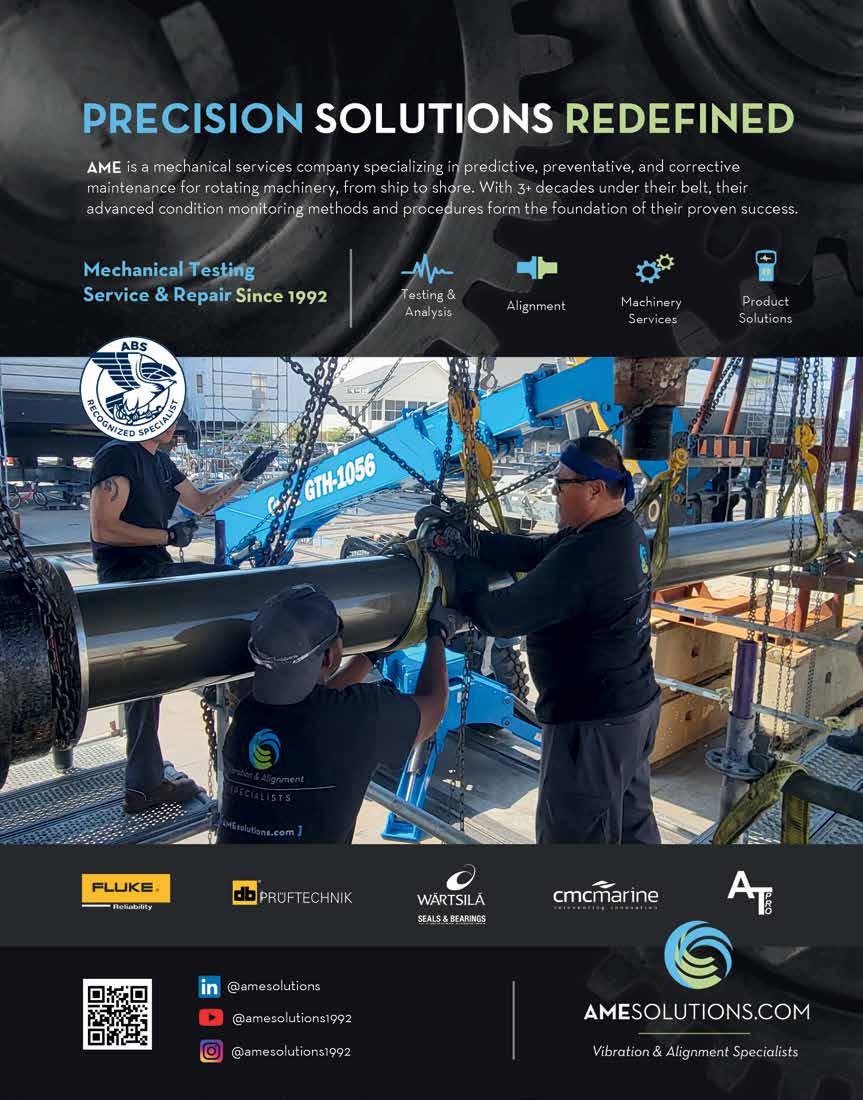
Xanthe Bowater is shaking things up. The former crewmember was inspired to create WaveWellness Solutions after returning to yachting following a four-year hiatus.
“I jumped in as stew again — but I couldn’t shake the question: why hadn’t anything changed when it came to how we talk about mental health and wellbeing on board?” she said. “That’s when I shifted into a freelance role and started building this project.”
WaveWellness Solutions offers a subscription-based wellbeing platform for crew, by crew. “We offer therapy, fitness, nutrition, and financial wellbeing support — all aimed at helping crew perform at their best and reducing the risk of burnout, conflict, or turnover on board,” Bowater said. “My therapy journey since returning to New Zealand in 2018 helped me realize just how much more awareness and access to support we need in this industry.”
WaveWellness officially launched in February 2025. Bowater learned basic coding to build her site and personally interviewed every therapist, dietitian, fitness expert, and financial advisor.
The monthly subscription fee includes one-on-one sessions with psychotherapists who understand yachting, as well as 24/7 access to a

library of mental health tools, meditations, fitness plans, and educational content. Chefs and stews receive biannual check-ins with a dietitian to support onboard nutrition, and WaveWellness also partners with ClassPass to give crew access to gyms and studios worldwide, along with a library of on-demand workouts. All crew can access an online portal for content, book appointments, and connect with providers, with confidentiality a core component.
“What sets WaveWellness apart is our whole-crew, holistic approach. No one else in the industry is offering mental, physical, and financial well-being support to entire crews in this way,” Bowater said. “When a full crew is supported, it creates a cultural shift on board — and that’s where the real impact happens.
“If … you aren’t prioritizing your crew’s well-being, it’s time to ask why not,” Bowater said. “Crew sacrifice a lot to be here — missing weddings, births, funerals — all to keep your operation running. If you’re not offering them real, consistent support in return, then don’t be surprised when they burn out or leave. There are better ways to do this, and WaveWellness is here to help lead that shift.”
wavewellnesss.com

If you’re looking for more female crew uniform options, your answer may be Quay Figures. Former Bosun Ellen Young founded her clothing brand in March 2025, specifically for women on deck and in the engineering department.
“My mission is to make sure women in these departments feel comfortable and confident in their uniform,” Young said. She was driven by her personal experience as a woman on deck, “frustrated and embarrassed” by her uniform. With limited options for fit and style, she realized the problem was widespread — every woman she has spoken to has received shorts that don’t fit, a skort (not practical for work on deck), or even men’s clothing.
“Women want to be taken seriously in these roles,” Young said. “We are coming up in volume and certifications. Uniform is one small thing that can be changed in this industry to
support these women and reflect the evolution of these traditionally male roles.”
Young knows what these women want and need from their uniforms. She currently offers a collection of three shorts — board shorts, “on charter” shorts, and “off charter” shorts — and one engineering coverall.
“I have designed shorts with intricate details that were lacking in my uniform,” she said. “I have included zippered pockets, large functional pockets, a high waist design, room and stretch in the thigh gap, with stretchy fabrics. They’re designed for performance while having a flattering silhouette.” She aims to bridge the gap between what’s available and what women truly want, which boils down to being able to do the job comfortably.
More importantly, she wants to empower women by supporting and encouraging their professional growth in the industry.
quayfigures.com




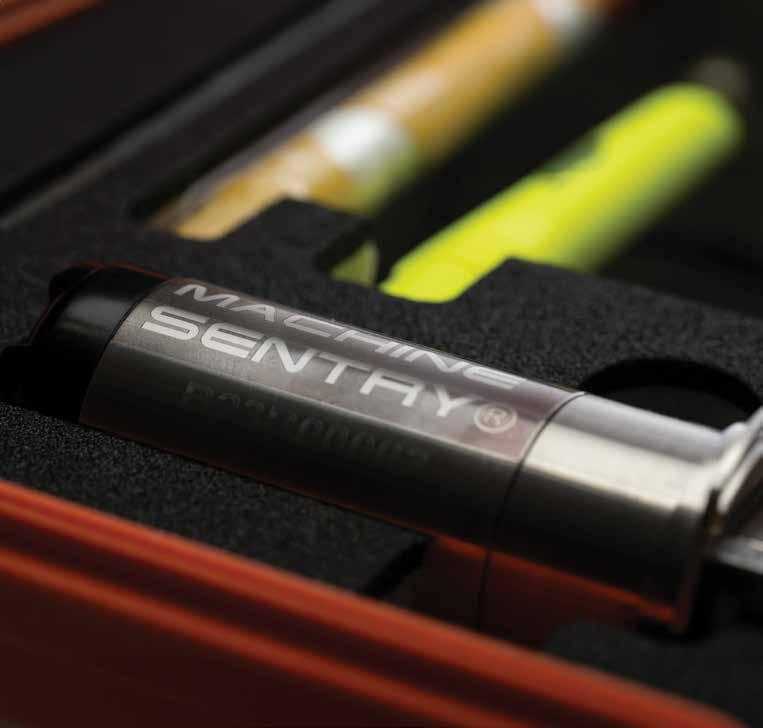


The nominees for this year’s ACREW Crew Awards have been announced in 14 categories. The annual awards shine a spotlight on the individuals who embody excellence, dedication, and passion within the superyacht industry. The nominee’s achievements will be reviewed by a panel of seasoned captains and industry professionals to determine the victors. The winners will be announced at the Crew Awards weekend in Ibiza, Spain, from Oct. 24–26. Check out the nominees!
Best Superyacht Crew Award
• M/Y Freedom
• M/Y Ocean Z
• M/Y Unbridled
• M/Y King Benji
• M/Y Sanctuary
• M/Y Galaxy
• M/Y Come Together
• M/Y Titania
Best Captain Master Unlimited Award
• Roberto Beretta
• William Henderson
• Greg Foster-James
• Nikos Sarris
• Ante Juresko
• Robert Novak
• Shaun Burford
Best Captain Master 3000GT Award
• Selim Akturk
• Charles Dugas-Standish
• Lance Hartley
• Gheorghiev Geni Dzenev
• Paul Bladon
• Pietro Borgo
• Dean Pilatti
• Clive Harrison
• Richard Lington
• Shaula Bolanos
Best Captain Master 500GT Award
• Brendan Emmons
• Daryn Dalton
• Karl Cutajar
• Kelly Gordon
• Sean Rysenbry
Best First Officer/Mate Crew Award
• Rebecca Denisco
• Sean Huyton
• Johnny Kanaan
• Nicholas Muldoon
• Güneş Baş
• Francesco Miccù
• Gareth Dovey
Best Chief Stew/Purser Crew Award
• Vesna Choklo
• Julie Emmons
• Cantleigh Groenewald
• Cathy Skinner
• Nadine Coronado
• Danielle Hemming
• Danielle de Wet
• Sydney Evans
• Caitlin Nugent
• Llewmari Nicolay
• Isabell Ruehle
• Hanna Miranda
• Sonja Capar
• Sarah Samou Marzocchi
• Jess Harbison
• Courtney Dow
Best Chef Crew Award
• Paulo Longhin
• Antonio Iaselli
• Daniel Stoma
• Jason Mcdonald
• Kendra Castello
• Vince Joseph
• David Perez
Best Environmental and Sustainability Crew Award
• Niki May Smith
• Leah Tennant
• Sean Rysenbry
• Shane Coopersmith
• Joanna Hirst
• Sam Stewart
Best Engineer and ETO Crew Award
• Waldemar Mueller
• Edgardo Pekic
• Max Whetter
Best Lifetime Achievement Crew Award
• Isobel Odendaal
• Begüm Doğulu
• Carmen Preda
• Graeme Lord
• Dean Dutoit
• Emma Baggett
Best Lead Deckhand/Bosun Crew Award
• Alexis Priebe
• Lilé Potgieter
• Lara du Preez
• Andreea Moldovan
Best Social Influencer/Content Creator Crew Award
• Cathy Skinner
• Alexis Priebe
• Kelly Gordon
• Lizzette Meyer
• Magdalena Nenadovic
• Liam Devlin
• João Franco
Best Junior Crew Award
• Lucy Bergstrom
• Yanilexy Vera
• Tia Wong
• Megan Munnik
• Jonathan Povey
• Nathan Marx
• Emile de Jager
• Preeti Singh
Best Mentor Crew Award
• Lilé Potgieter
• Kelly Gordon
• Alice Baker
• Don Mckee
• Karine Rayson
• Gemma Hulbert
• Dean Pilatti
• Tracey Boston
• Jess Harbison
• Mayte Bruguera











By Kevin Maher
Flashing lights, delectable bites, premier drinks, and more than 900 people surrounded Christine Battles and Megan Lagasse when they walked into JA World Uncorked in January 2018. The two attended on a whim, enjoying the food and wine extravaganza at JA World Huizenga Center until they both questioned the festival’s purpose. That’s when they learned more about the Junior Achievement of South Florida (JASF) located in Coconut Creek, Florida, an organization that empowers youth with knowledge, ability, and confidence to navigate their future. The purpose moved Battles and Lagasse, but they believed something was missing in JASF’s
coverage — the maritime industry.
“Megan and I talked about this, and we said, ‘How is it possible that the yachting capital of the world is here in South Florida and there isn’t a presence here,’” Battles said.
JASF helps more than 20,000 eighth grade students from Broward County and south Palm Beach Counties learn how financial decisions will impact their lives at the Patten Family Finance Park, a sprawling education center that students visit annually. The center consists of mini storefronts, like a mayor hall where students learn how to vote, a Publix, and a TV station. After discussions with JASF’s senior development directors, Battles and Lagasse learned there was a storefront opening within Finance Park. However, the cost was $40,000 a year and required a three-year commitment. Unphased, Battles and Lagasse got to work.
“Megan and I got in touch with Lisa Morley, with Maritime Professional Training, and Lucy Reed, with
The Triton, and we raised $137,000 in six weeks,” Battles said.
Spearheaded by Creator and Cofounder Battles and Co-founder Lagasse, the team got 24 partners to make financial commitments. With Battles’ experience as chief administrative officer of Advanced Mechanical Enterprises (AME) and Lagasse’s as marine director for Pier Sixty-Six, “Sea the World” was born in May 2019.
“The kids only know what they know, and the more exposure we can give kids to different jobs on the water, the better,” Lagasse said. “We need new people in our industry, and this is how you start.”
Sea the World’s marine industry storefront started as nine walls and think tanks that covered different careers in the maritime industry and has evolved to follow new education techniques. Now, the space includes a 3D life-size container ship display, augmented reality, iPads for online scavenger hunts, and other facilities that educate students on eight
career paths in the maritime industry, with a hope of instilling a passion for maritime in them.
“We definitely have an issue with age gaps when it comes to service, and we need to do better at filling that gap,” Lagasse said. “With this new group of people coming into the industry, we have an opportunity.”
“The way we fill the pipeline is by getting more students to understand that this is a direction they can go when they get out of high school, and that there’s so many jobs that you don’t have to go to college for,” Battles said.
As Sea the World has grown since 2019, so have the programs available for students through JASF. High school seniors who aren’t interested in college can commit six months of their senior year to the JA Pre-Apprenticeship Program. The program is a work-based learning experience where seniors learn soft skills, gain industry certifications,


and explore careers through worksite tours. Students learn about construction, telecommunications, water treatment utilities, and the maritime industry.

young and green, and didn’t have any bad habits. We were able to teach him the right way from the beginning, and he's been with us for almost two years now.”
jasouthflorida.org amesolutions.com piersixtysix.com

“Throughout the six-month preapprenticeship program, students get to go on tours to places like Pier SixtySix, Port Everglades, to AME and to DeAngelo Marine Exhaust,” Battles said. “They’re seeing all those things three months before they graduate high school, and then they choose a career path where their information is more detailed.”
Students who go down the maritime path gain certifications like a maritime 10-hour OSHA, first aid, and forklift driving, along with soft skills like how to build a resume, have a successful interview, and create a LinkedIn profile. The program has grown from 25 students in 2021–22 to 258 students in 2024–25, with success stories like Armani Hosang. Hosang now works for AME after going through JASF’s PreApprenticeship Program and the Marine Industries Association of South Florida’s apprenticeship program.
“Armani was graduating high school and didn’t want to go to college, so we interviewed him,” Battles said. “He was
With Sea the World and JASF’s PreApprenticeship Program successfully funneling young, talented professionals into the maritime industry, Lagasse says she’s seen more successful changes in the dialogue surrounding a career path outside of college too.
“An overall success story is changing the dialogue, telling kids it’s ok not to go to college and you can be successful in whatever path you choose,” Lagasse said. “It’s important to make sure kids are successful and feel confident, and this gives them that boost that I think everyone needs.”
As Battles and Lagasse continue to work towards educating the youth on maritime opportunities available, they need help. Companies can contact them to become donors or volunteer at JASF, industry professionals can volunteer at JASF and help change student’s futures, and anyone can share their story to help them continue to grow. ‹

By Dorie Cox
Corals are in an unfair fight. As microscopic marine animals, they battle giant forces of warming seas, pollution, tourism, reef destruction, unsustainable fishing, and invasive species.
More than 60% of the world’s reefs are at risk, according to the World Resource Institute, and nearly 90% of Florida’s coral reefs have been decimated over the last 40 years, according to the National Oceanic and Atmospheric Administration.
However, corals have allies in the ring because coral reefs protect coastlines, livelihoods, and ways of life, according to Alice Grainger, senior director of strategic engagement at Coral Restoration Foundation (CRF).
“A healthy reef will reduce up to 97% of wave energy before it hits the shore — that’s the difference between water gently lapping at the beach and a wave smashing into homes,” she said.
To the rescue are scientists, researchers, advocates, and volunteers to attack on a variety of fronts. Since it takes millions of corals to make a reef, many groups work to propagate the endangered creatures. Some harvest “coral of opportunity” that have been naturally dislodged in storms or wrecks, while others collect polyps or larvae to propagate in laboratories and sea farms. Most groups replant, maintain, and monitor corals after they are “outplanted,” or moved onto artificial or existing reefs.


On the frontlines are a few of these innovations and innovators:
Land-based coral cultivation is just one tool used by the Reef Renewal Foundation to enhance large-scale coral repopulation, testing, and the maintenance of a gene bank.
Coral-attracting chemicals are being tested by researchers at UC San Diego’s Scripps Institution of Oceanography and Jacobs School of Engineering. A nano-particle gel applied to reefs releases chemical signals that encourage coral larvae to settle and grow where a damaged reef might emit deterrent cues.
Microfragmentation increases the growth rates and numbers of corals quickly. The Mote Marine Laboratory’s process is growing micro-sized pieces from cuttings of larger fragments of live coral for outplanting.
Coral Trees grow coral with a simple, low-footprint, scalable tool from CRF. The vertical “trees” house coral nurseries in the open ocean. These corals grow to basketball size in six to nine months, and are then harvested and rehomed onto reefs, according to Grainger.
Reef Stars are hexagonal steel structures deployed for artificial reefs in areas of damage. The Mars Assisted Reef Restoration System showcase is the HOPE Reef in Indonesia, formerly a dead field of coral rubble, that now has spawned new growth.

Coral Clips by Coral Nurture are nails with a metal clip used to attach coral outplants directly to reefs. Transplantations have been used on the Great Barrier Reef for coral fragments to quickly anchor to a reef from a donor reef or nursery. More than 100,000 outplants have been attached to date.
Intentionally Built Artificial Reefs include art and memorial structures deployed as artificial reefs. The 1000 Mermaids Artificial Reef Project includes underwater sculptures designed to enhance marine habitats and Eternal Reefs allow supporters to live on as part of an artificial reef with memorial markers from Reef Ball Foundation and Reef Innovations.
Each effort makes a difference.
“We are not saving the planet — the planet will survive,” Grainger said. “It’s been through mass extinctions before. What’s at stake now is us — humanity. That’s why this work matters, it’s not just about marine life, it’s about supporting communities.”
Although coral restoration is not the whole answer, it is an essential part of the solution.
“Right now, we know that, at the very least, we are preventing the extinction of these species,” Grainger said. “And that’s something worth fighting for.” ‹

Ice
Maiwenn
shares her insights into how captains with an interest in the Arctic can best position themselves for an industry with very few jobs.
By Emma Coady

“Ice Queen” Capt. Maiwenn Beadle has more than 30 years’ experience sailing. She has led groundbreaking expeditions through Arctic waters to 79°N and through the Northwest Passage, commanded a 75-meter ice-breaking expedition yacht in Svalbard, Greenland, and specializes in sharing the magic of the Arctic with explorers.
Most yachts require an ice navigator to operate in the Arctic, even during the summer. Since Arctic charting is notoriously poor, many areas remain uncharted, and the chart datum is often inaccurate. Great care is required to operate safely, and this is one of the reasons polar experience is mandated for bridge crew bringing vessels into polar regions. An independent ice navigator works across various vessels in the Arctic, supporting expeditions in both an advisory role and helping navigate unique challenges like ice and poor charting.
Becoming an ice navigator is a path some captains with an ambition to operate in the polar areas can consider, rather than gaining experience through yachting in polar waters. Several excellent companies operate small expedition vessels in these remote areas, offering numerous learning opportunities. Thanks to her experience
on expedition passenger vessels, Beadle was fortunate to find herself running a vessel that spent most of its cruising time in the Arctic.
“Before venturing into remote territory, you need as many years working as a captain as possible. It is the most challenging navigation in the world, and you need to be 100% comfortable with all methods of navigation and with organizing logistics in extreme conditions,” Beadle said.
Due to the challenging nature of most yacht operations in the polar regions, masters and deck officers serving on ships must satisfy the statutory requirements under the International Maritime Organization Polar Code to equip them with the advanced knowledge and skills necessary to navigate and manage vessels in polar waters safely. These vessels must be led by an experienced ice navigator who holds an STCW Polar Advanced or above. Few yacht officers have spent enough time in polar waters to fulfill the 60-day requirement.
“The best way to learn and understand ice navigation is to spend time doing it. All the theory in the world cannot prepare you for the realities of the situation,” Beadle said.
One of the key roles an ice navigator fulfills on board is training the bridge team and sharing knowledge. She recommends working alongside someone with experience in the field to gain a more thorough understanding of the region.
“People who regularly work in this field are incredibly open and supportive with knowledge sharing and make time to help each other. It’s a small community in a field that requires both skill and humility,” Beadle said.
Ice navigators should possess a sense of adventure and a hardiness to challenging environments with a sense of humanity important as well. Ice navigators need to have an understanding of the mental health challenges that can come with living in extreme environments and the effect that can have on crewmembers.
Just as the Arctic can challenge mental fortitude, it can create beautiful moments too. Beadle has witnessed passengers reduced to tears at seeing their first whale and helped guests with the dream of being helicoptered up to an ice bar on a glacier.
“Everyone sees things from a different perspective — the magic of the Arctic is different for everyone,” she said. ‹
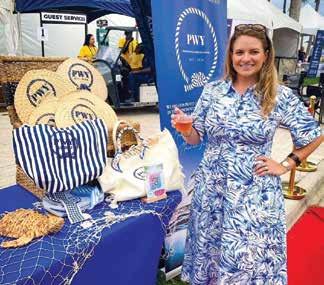

Samantha Moore is the founder of Professional Women in Yachting (PWY), a 501(c)(3) nonprofit organization that empowers women in the yachting industry while fundraising for marine science and ocean conservation. The organization has helped countless women in the yachting industry make friendships and find professional success since 2022, but Moore’s journey to become the architect behind PWY started long before that.

By Kevin Maher
Moore’s introduction to the yachting industry came through her father, Dan Moore of Coastal Group Marinas. Growing up, Moore would operate a 13-foot Boston Whaler with her father to go pick up Friday night pizza on the Jersey shore. Her family’s love for the water steered her further into the yachting industry while instilling a love for marine life. She eventually tried her hand at marine insurance, but it wasn’t for her. Becoming a broker was her next goal, but she had difficulty in that due to one thing — her gender.
“I asked pretty much everybody I knew to get a yacht broker license, and everybody pretty much told me no. There was no downside in anybody licensing me — it was free to them and if I sold a boat under their brokerage, they would get 50% of my commission,” Moore said. “[It was very confusing to me] to have all these noes told to me consistently, and it turned out to be what I thought was, ‘I’m a girl and no girls really sell boats.’”
Still, Moore acquired her license but found herself fighting an uphill battle. Selling boats as a young, green female with no help wasn’t easy. She decided becoming a stew would help her learn more about the boats she wanted to sell, so she crewed on boats from 80 to 238 feet for a few months — having an awesome experience while doing so. After leaving
her crew job, she began looking for women who had struggled like she did to help her but found nothing.
“I ended up creating Professional Women in Yachting, mainly born out of anger,” Moore said. “I was mad at how hard it was for me, an educated, wellconnected, young, hungry female, and I couldn’t really get anywhere — it was always one step forward, two steps back.”
She knew there were other women dealing with the same struggles, and she was right. PWY was created and her first event was an immediate hit. More than 50 women attended, even while Moore was in the process of teaching herself how to acquire a 501(c)(3) designation and figuring out the organization’s mission.
“It was really well-received by the community — I feel like women were kind of dying for something like this,” Moore said. “It was exactly what I had envisioned and wanted, a community of women to support and go to for advice, friendship, to lean on, and professional opinions.”
At 52 members strong and hosting an event at last year’s Monaco Yacht Show, PWY became an international success for empowering women in yachting. Moore suddenly found men approaching her and apologizing for how they had done wrong in the past.
“It empowered us to speak out about men who were doing a disservice to
“The organization has made women feel more comfortable standing up for themselves to men in these ways — like sexual harassment first and foremost, and then gender discrimination.”
–Samantha Moore
themselves, the industry, and to us,” Moore said. “The organization has made women feel more comfortable standing up for themselves to men in these ways — like sexual harassment first and foremost, and then gender discrimination.”
Moore has even assisted female crewmembers who have found themselves wanting to leave the boat they’re working on, but their captain won’t let them. Moore has helped crew better understand their rights, put them in contact with maritime attorneys through PWY, and helped them get off board with the Coast Guard a call away if needed. However, Moore wants it to be known her organization isn’t against men.
“Our bylaws say men can join,” Moore said. “We love men that support women, and we would happily include you. Some of these smart men buy tickets to our allgirl events because, well, they’re like one guy and then 40 women.”

PWY’s mission stretches further than just empowering women. Moore raises money for marine science and ocean conservation through PWY, but she has a more specific, tangible goal as well. Moore works with the Marine Environmental Education Center (MEEC) at the Carpenter House, which helps educate the community about sea turtles, conservation, and marine life.
After lobbying the city, Moore’s goal is to build a sea turtle hospital and emergency manatee rescue in Hollywood beach next to the MEEC.
“We got in touch with Nova Southeastern University (NSU),” Moore said. “[They] said, if you can build it, we will fund the daily uptake of it and have our students manage it.”
PWY events like forums, panels, and their annual Baby Sea Turtle Hatchling Release Beach Bash — a cocktail party and dinner at NSU, followed by a 45-minute presentation on sea turtles and then a trip to the beach to release baby sea turtles into the ocean — help inch closer to PWY’s goal. Captains, crewmembers, and industry professionals are all invited to join PWY, become sponsors, or help with volunteer work for PWY’s mission to empower women and help the environment in the process.
“The mission is happening,” Moore said. “To see the industry gain traction behind it is what the dream is.” ‹






• Medical kits & service When you need

• Floating electric dive systems (Nomad, Sealion)
• Scuba gear sales & service
• Scuba training
• Tankfill systems (Nitrox & Helium)
• Water toys (Seabob, Fliteboard eFoil & more)
• Spearguns
• Freediving gear
Brownie’s Southport Divers. 1530 Cordova Road. Fort Lauderdale, FL. 954-524-2112
Brownie’s Yacht Toys. 2301 S. Federal Highway. Fort Lauderdale, FL. 954-463-9446
Brownie’s Palm Beach Diver. 3619 Broadway (US1). Riviera Beach, FL. 561-844-3483






In today’s world of chartering, it takes more than a stunning view or five-star service to make an impression. To enhance the experience, intimate details are being added to elevate trips into extraordinary memories.
Patrick Knowles, a well-respected designer with more than 40 years of experience, has shaped high-end interiors for private aircraft and superyachts.
Growing up in the Bahamas instilled a love for the ocean in him, which influences his work. After moving to the U.S. in 1983, he earned a degree in architecture and began his career in the marine industry in 1989. By 1999, he launched his design firm, known for its classic yet personalized approach.
“There was never a template,” Knowles said. “Each project had to reflect the client’s identity and lifestyle.”
That same mindset inspired the launch of Yacht Life Caviar, a luxury brand that emerged during the pandemic. When the owner of M/Y Alta requested an exclusive vodka for the vessel, Knowles delivered a spirit so rare that a single pour was valued at $185,000. The experience sparked an idea: to create curated products that go beyond luxury by telling a story.
“I realized we could create experiences that weren’t just luxurious, but meaningful,” Knowles said. “Something guests could connect to and remember.”
From there, Yacht Life Brands was born, reflecting what Knowles calls the “quintessential yachtsman” lifestyle. The brand is meant to appeal to an aspirational
audience seeking authenticity. The caviar collection features nine varieties, each inspired by Knowles’ design projects.
“It’s not about having the biggest boat,” Knowles said. “It’s about living with intention, elegance, and ease. This brand reflects that mindset.”
Focused on vessels in the 25- to 50-foot range, Yacht Life Caviar offers guests something elevated yet accessible. Whether hosting friends or thanking a captain, it provides a genuine connection to the lifestyle.
“It’s real,” Knowles added. “I’m still designing, still living this life. The brand is grounded in that experience.”
In Mallorca, Spain, Arman Ebbens is redefining what it means to offer hightouch, customized experiences in the charter world. Born in the Netherlands, Ebbens was raised in a supportive household. His family moved to Mallorca when he was 14 to pursue his father’s business, a change that shaped Ebbens’s entrepreneurial mindset.
From a young age, he was drawn to building, first with Legos and later with a passion for creating real-world systems that worked. He was inspired to launch his real estate venture during the 2020 quarantine, a buyer-focused consulting firm known as Ebbens Official.

“It runs in the family, it’s in our blood,” he said. “I wanted to help others avoid the difficult path we had to learn on our own.”
His business quickly gained traction across both residential and commercial markets, expanding throughout Western Europe as one of the only buyer-side firms in the region. That same attention to detail carried into yachting, where clients sought Ebbens’s help in creating unique charter experiences.
“I saw a gap where my perfectionism could add real value,” Ebbens said.
Each experience begins with a blank canvas, helping clients articulate their dreams and then executing every
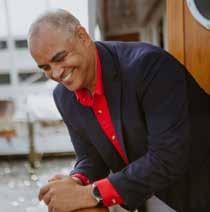
“This is a luxury market; clients value transparency.”
– Arman Ebbens

detail to match. One example involved Ebbens creating a romantic and heartfelt expedition for a couple seeking a once-ina-lifetime moment. “The emotion was the most important part.”
While he remains budget-conscious, Ebbens emphasizes that luxury comes with realistic expectations. “Being honest goes a long way,” he said. “This is a luxury market; clients value transparency.”
With a clear mission to help people achieve their vision, his brand is renowned for loyalty, authenticity, and custom experiences crafted with heart.
From caviar to curated charters, both Knowles and Ebbens are delivering modern luxury with meaning. For today’s guests, it’s not just about being impressed, but feeling seen, understood, and inspired — and that’s an experience worth coming back for. ‹
BY GINA RAGUSA

Capt. Sandy Yawn can’t go a day without hearing the same question from “Below Deck Mediterranean” fans: How do you actually get into yachting?
What often appears glamorous on Bravo — jet-setting and luxury yachts — has sparked a surge of interest in a oncehidden industry, thanks in large part to the series that introduced global audiences to the real-life grit behind the glitz.
Since the show’s debut, career interest in yachting has skyrocketed. From 2017 to 2019, crew job requests jumped 18%, followed by a staggering 45% spike in 2021 over the previous year, according to the 2021 Annual YPI Crew Report.
Recognizing the need for access and guidance, Capt. Sandy, alongside Lobbyist Susan Goldstein, launched a mission-driven initiative with the help of Young Minds Inspired, provider of free educational outreach programs, to demystify the maritime world and open the door to the vast — and often overlooked — career opportunities it holds.
“It’s already seen great success,” Yawn said. “What many people don’t realize is that the maritime industry isn’t just about going to sea — there are incredible land-


based careers, too. A lot of Americans aren’t eager to travel far from home, which is why you don’t see many on ‘Below Deck.’ It’s not a casting issue — it’s a cultural one.
“We weren’t raised to think of travel or the marine industry as career options, and that’s what I’m working to change. There are welders, electricians, carpenters, and marine technicians who can earn up to 20% more working in a shipyard than in traditional land-based jobs. Our curriculum teaches geography, STEM, and career awareness in an interactive way — and we’re just getting started.”
Lori Wheeler, vice president of the Marine Industries Association of South Florida, says the need to fill positions will become increasingly important as demand continues to grow.
“The marine industry is evolving rapidly, and over the next decade, we can expect significant growth in career opportunities, especially as we address the widening skills gap across technical trades,” Wheeler said. “As seasoned professionals retire, the demand for trained workers continues to rise, but the pipeline of talent has not kept pace. We’re seeing a critical need not only to train new people but to ensure that training aligns with the industry’s shifting needs, including advanced technologies, sustainability efforts, and specialized trades.”
That’s why the team at Captain Sandy’s Charities has put efforts into high gear. Helming the Steering Toward Success boots on the ground push is the charity’s director of strategic partnerships, Liz Schmidt, who says her mission is to ensure every student has marine job opportunities on their exploration list.
“We want every student exploring their future to know there are exciting, high-growth career paths beyond college and traditional trades — options that offer both financial stability and long-term success,” Schmidt said. ‹


Team Capt. Sandy can’t do it alone — and we need your help. One of the most impactful ways to grow the industry is by becoming a mentor and volunteering at outreach events. We’ll also be hosting fundraising and career fairs in the coming months. Contact doug@captainsandyscharities.org for more information.
You can further support this mission by purchasing the limited edition specialty license plate, which directly funds job training, education, and career pathways across Florida. To make an even bigger difference, consider donating, spreading the word, or getting involved at captainsandyscharities.org.
By Kevin Maher
Catch up on the quirkiest maritime news from around the world!
Loggerhead

The Loggerhead Marinelife Center in Juno Beach, Florida, rescued “Dilly Dally,” a loggerhead sea turtle, in January. Dilly Dally arrived with some predator injuries and eventually needed one of her front flippers amputated. Despite the setback, Dilly Dally made a great recovery and was released back into the wild on June 4.
In collaboration with the Smithsonian, the Loggerhead Marinelife Center placed a satellite transmitter on Dilly Dally’s shell to better understand how these animals readapt once they’re back in the wild. Her transmitter is now active and Dilly Dally can be tracked on the Loggerhead Marinelife Center’s website. marinelife.org

A message in a bottle sent to sea on January 14, 1983, was found by Mark Doucette, an archaeology technician, on Sable Island in Nova Scotia, Canada. Although the message was faded, it was determined to have been sent from a resupply ship operating near Sable Island. The bottle also contained a Canadian two-dollar bill, which ceased printing in 1996.
Oregon Man Goes Viral After Quitting his Job to Sail the World with his Cat

Oliver Widger, a 29-year-old man from Oregon, quit his job at a tire company and cashed out his 401(k) after growing tired of working in corporate America and being diagnosed with Klippel–Feil syndrome a year ago. He decided life at sea was where he needed to be, and taught himself how to sail, mostly off YouTube, and refit a sailboat he bought.
He set sail to Hawaii from Warrenton Marina in Oregon on April 30, marking his first time sailing outside a river. Widger brought along Phoenix, his cat that he rescued from a dumpster seven years ago. With the help of Starlink, Widger posted updates on his journey, amassing millions of views and followers that rooted for his quest against corporate America.
After 24 days at sea, Widger and Phoenix arrived in Oahu to a crowd of fans at Ala Wai Harbor. He was also greeted by Governor Josh Green, who presented him with an award for his achievement. Widger announced his arrival to his followers with one simple sentence: “Dear Corporate America, I won.”

The French Navy discovered a shipwreck off the coast of Ramatuelle during a military operation on the seabed on March 4. The unmapped wreck was discovered more than 2,500 meters deep and stretches more than 30 meters long and seven meters wide. The French Department of Underwater and Submarine Archaeological Research (DRASSM) announced its findings on June 11, sharing that it was believed to be a 16th-century trading ship due to a ceramic shipment aboard.
The wreck, which has been named Camarat 4, is the deepest wreck ever found in French waters. DRASSM believes the wreck was preserved so well due to its depth, which kept it from degrading. Exploration and targeted sample retrieval will now be conducted by experts, archaeologists, ceramic specialists, and others.










Beginnings and endings offer their own unique excitement and bittersweet emotions as one chapter closes and another begins. Triton looks to help crew with their yachting journey — whether you're a greenie or a seasoned pro.
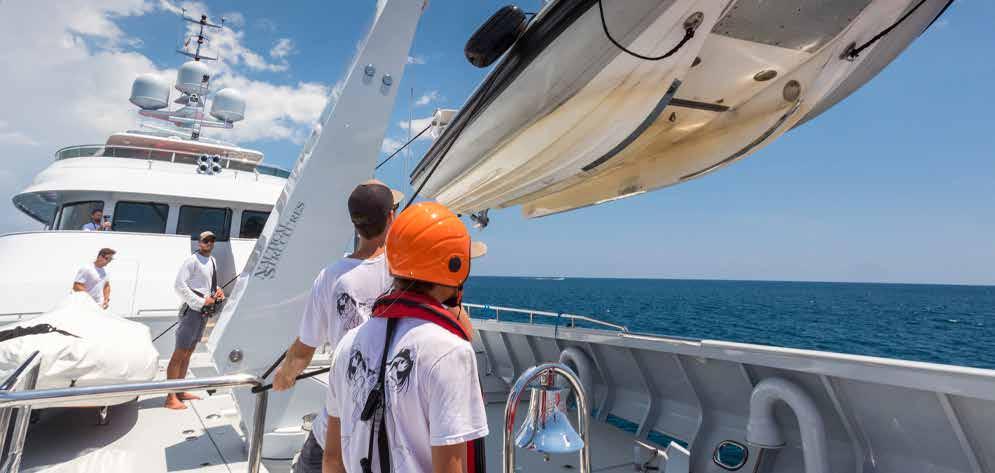
BY LAUREN BECK
Getting your first crew job can be a matter of luck and timing. As Don Mckee, cofounder and director of YOA Yacht Crew, said, “I wish I could give you a onesize-fits-all answer, but there just isn’t one.”
It also won’t be easy. “It is the hardest time ever to try and get a yacht job,” said Liam Dobbin, managing director of Wilson Halligan. By his estimate, Wilson Halligan has about 100 new crew registering each month. There aren’t enough jobs.
“Competition is fierce,” said Marcy Williams, director of crew placement at Northrop & Johnson in Fort Lauderdale.
Here’s how you can best set yourself up for success.
To start, “Ensure you are in the location where the boats are located,” Williams said. “You have to have your boots on the ground in the yachting hubs for that season.”
In one blog, Reardon Yacht Consulting (RYC) recommends key yachting hubs, like Fort Lauderdale, Antibes, Monaco, Palma, and Antigua, as good spots to
find work. Keep in mind the seasons — they recommend the top times as April and May for the Mediterranean season, September and October for the Caribbean season, and December and January as a turnover period after the holidays.
Stay legal — and it’s the crewmember’s duty to understand what they can do according to their visa and location. “This information is best sourced from reputable agents rather than Facebook or WhatsApp groups,” Mckee said.
Despite rumors, no changes have been made to U.S. B1/B2 visa regulations; however, enforcement appears to have intensified. Dobbin also explains that Brexit has made it more challenging for U.K. crew in the Med, which adds another layer of difficulty to the job market.
Before you turn up at a yachting hotspot, make sure you understand what you’re getting into — understand the local regulations, where to stay, potential costs, and more.
“It’s not for the faint of heart,” Williams
said. “If you want to do this for a ‘gap year,’ I would suggest finding something else to do. It is a big investment for the yacht, and if you are just going to leave… there is no point.”
Joanne Cooper of RYC stresses the importance of verifying information you see, especially regarding legal and visa matters. Like Mckee, RYC advises crew to consult reputable sources.
“We should be encouraging people to go to lawyers, go to the appropriate domestic overseeing body to make sure [crew are] doing things properly, and avoiding social media or faceless accounts giving out unsolicited advice.”
There can be big consequences to your career and life if you make a mistake. Be smart and educate yourself.
Dockwalking has become harder. Crew must be legally able to dockwalk in the region before heading to any marina. “I do recommend it for U.S. passport crew in the U.S. as long as the marina allows it,” Lauren Cotton, director of Cotton Crews, said.


“SHOW UP SOBER, IN CLEAN CLOTHES, AND BE ON TIME — JUST LIKE AN INTERVIEW.”
In Dobbin’s current experience, dockwalking in Antibes and other hotspots has been dead. He recently conducted a seminar in Antibes, and more than 150 crew attended, most of whom had been there for a month with no daywork.
“Remember that first impressions count and that you more than likely will get a lot of ‘noes.’ Try not to take it personally and remember that all you need is one yes to prove yourself,” Mckee said.
Treat daywork like the trial it is. It’s an interview, and your chance to demonstrate your talents. “STAY OFF YOUR PHONE!” Cotton said. “Show up sober, in clean clothes, and be on time — just like an interview.” She also offers an extra tip: “Honor the pecking order at lunch time, meaning if they offer you lunch, you eat last.”
“Make sure you LISTEN, keep your head down, be respectful, do the job to the best of your ability, and follow instructions,” Williams said.
Mckee offers another vital tip: Do not work for free. “There are many yachts and companies that exploit crew eager to gain
– Lauren Cotton
experience and put something on their CV,” he said. “I find it inexcusable that this is still happening. Inexperienced or not, crew deserve to be paid for the work they do.”
Finding work can be all about who you know and making connections. All crew agents agreed it’s vital. Cotton recommends staying in crew housing to meet other crew, attending crew and industry events, and meeting crew agents in person.
Most recommend joining Facebook groups that post networking events, or keep your eyes open for industry publications, like Triton, which hosts networking events regularly.
Be judicious in how you network. “Networking does not involve going to the yachtie pubs and getting drunk, etc.,” Mckee said.
Harness the power of social media. “Use social media to your advantage,” Dobbin said. “The world is getting smaller and smaller, even having a pristine LinkedIn profile can help — lots of captains, yacht managers, or recruiters are on LinkedIn. Engage with them.”
He advises crew to find the line between engagement and harassment. Don’t email agents daily to ask about jobs; instead, consider scheduling an in-person meeting. “A phone call, which is almost a lost art, sometimes can be really nice,” Dobbin said. While an in-person drop-by might be tempting, he warns crew against doing so without an appointment, as some agencies accept only a limited number of in-person meetings each week.
“It should go without saying, but everything matters and that includes how you conduct yourself in public, through your correspondence with agents (via email, phone, and WhatsApp messages), during interviews, and in your daywork and trial period,” Mckee said. “Given how competitive the job market is, the small things matter more than ever.” ‹

Triton spoke to several captains and crew to find out their advice to crewmembers just entering the yachting industry.
By Lauren Beck

What advice would you give someone just starting out in yachting?
“The first few years are going to be a steep learning curve with a lot of grafting, but take the time to appreciate that it’s still a million times better from some of the average land-based jobs out there.”
– Head Chef Nina Wilson, M/Y Loon
“Be ready to work hard. It's not what you see on TV. Put your phone down. I realize everyone is on them, but you need to be a valuable team member before you get that privilege.” – Capt. Kelly Esser
“I still have some of my friends from childhood back home in the Netherlands who still say, I wish I had done what you do… So just go and try it out. Get your required minimal STCW and ENG 1,
and off you go. You will find out yourself if this is for you.” – Capt. Marcus Desaunois, M/Y Axis
“I wish I had been brave and bold enough to ask more questions during my interviews with recruiting agents as well as with captains, especially the interviews in the very beginning of my career. Over the years, I came to realize that questions about the yacht and its program can and should be asked by every potential crewmember — questions about crew dynamics on board, the onboard culture, longevity of the crew and reasons for crew changes, benefits like health insurance and training opportunities and even the possibility of attractive things like progression up the ranks and even rotation (depending on the program and size of vessel). Early on, I was so focused on getting hired that I didn’t really think of the significance of opening these conversations.” – Tracey Boston, former crewmember and founder of Our Faceless Crew
“Stay humble, stay hungry. This industry rewards those who are curious, professional, and proactive. Say yes to learning, even when it’s outside your job title. Be a good teammate. That energy, consistency, and positive attitude will get noticed faster than you think.”
– Capt. Liam Devlin, M/Y Unbridled
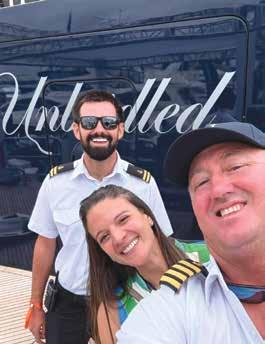
What do you wish you’d known before you began your own career?
“I wish I had started out in the galley from the start! Whilst it was great fun being a stew for a few seasons, and then a deckhand for a few years, I can’t help but think how different it would have been going all in on the galley from the start.”
– Head Chef Nina Wilson, M/Y Loon
“The industry has changed so much. To have a career in yachting today, you kind of need to know what you want in life. You can go the easy route or the hard/expensive route. I feel like kids today just are all over the place. Most importantly, you need to save for the future.” – Capt. Kelly Esser
“I wish I had started earlier with off-the-beaten-track and Arctic yacht expeditions. Now freshly minted with a Nautical Institute-accredited Ice Navigator Level 2 license, more adventures ahead, I just wish I had started all this 20 years earlier.”
– Capt. Marcus Desaunois, M/Y Axis
“Stay humble, stay hungry. This industry rewards those who are curious, professional, and proactive. Say yes to learning, even when it’s outside your job title. Be a good teammate. That energy, consistency, and positive attitude will get noticed faster than you think.”
– Capt. Liam Devlin
“To anyone new to the industry, I’d say start developing the skills that truly matter on board. Captains and recruiters look for more than just certificates. They value adaptability, teamwork, and solid communication, so express this to them if it matches who you are. Life on a yacht can be intense, and being calm, collaborative, and solutionsoriented will set you apart. Whether it’s through hospitality-based jobs, microlearning online courses, or in-person programs, or simply practicing clear communication, start building those habits now. Improvement in leadership is an important topic being highlighted in the industry, so take a leadership course. A strong, long-term career in yachting is as much about mindset as it is about technical skills.” – Tracey Boston, former crewmember and founder of Our Faceless Crew
“That it’s not just about boats, it’s about people. Technical skills are vital, but emotional intelligence, resilience, and communication are what truly shape your success. The industry is fast-paced and can feel overwhelming at times, so learning how to manage stress, find balance, and build a strong crew culture is essential.” – Capt. Liam Devlin, M/Y Unbridled. ‹



By Steve Davis

ecoming a superyacht crewmember takes more than desire.
Mandatory qualifications, like safety training and medical certificates, additional training for specific roles on board, and a strong work ethic are necessary elements to get hired. It all takes time and money, and chances are, you’ll be spending it away from home. While you’re working to obtain those licenses or that dream job, you’ll need a place to stay — hopefully one that won’t break the bank.
Superyacht crew training is widely available from the U.S. to the Med, England, Asia, and down to Australia, but odds are, many will find themselves in the Fort Lauderdale area or in Antibes, France. With a variety of training schools, marinas, and yards, dedicated crew accommodations, or crew houses, play an important part in a yachtie’s life, from affordability to networking to support.
“We offer accommodations tailored for yachting professionals, from those just starting out to industry vets to full crews looking for a home while their boat is out of the water or being serviced,” said Jamie Smith, owner of Crew Haven in Fort Lauderdale. “While there are other housing options available in these areas, what truly sets us apart is our unique business model that prioritizes giving back.”
Smith is a former crewmember who realized the need for affordable accommodations when not working. She was able to earn enough for a house down payment and rented her two extra bedrooms to help make the payments, saving every penny from her work as a stewardess to invest in the property. It was that experience that made her realize the true value of crew housing.
“We offer referral discounts, host networking events throughout the year, and we’ve maintained helpful collaborations with other industry professionals for training courses, meet and greets, Q&As,” she said. “We also provide our guests access to an exclusive ‘Crew Haven Community’ group chat where many crew post to our job board and help assist others in finding their next dream job. Many of our residents express a strong sense of community — we learn from one another, support each other, and create a place to call home, while being thousands of miles away from family and friends.”
Crew accommodations can vary from shared rooms, to a private room in shared houses, to a fully private home. Both short-term and long-term stays are available, and prices are typically much less than staying in a hotel — especially when you consider the perks. It’s essential to remember certain factors when looking for crew housing, especially when it comes to safety and security.
“Just like on a vessel, it’s important to put health and safety first,” Smith said. “Check that your host offers things like self-locking doors, exterior cameras, fire extinguishers, first aid kits, and local emergency contact information prior to booking.”
That also translates to the neighbor-

“Quality housing plays a significant role in setting crewmembers up for success.”
–Jamie Smith
Like the yacht, cleanliness and sanitation are key both around the crew house and the surrounding area. Also consider the type of accommodation — are you looking to network or need a quiet place to study? It all has an influence on your state of mind.
“Quality housing plays a significant role in setting crewmembers up for success,” Smith added. A safe place to stay eases the nervous green crew and provides a positive outlook on their path forward. “We’re a stepping stone for industry hopefuls and a familiar friendly face for our vets.”
No matter where you decide to follow your dream as yacht crew, upgrade your license, or stay during a refit, finding that home away from home is an important part of making it easier to find a friendly face, adjust your psyche, and enjoy your time ashore. ‹



By Lauren Beck
When you’re new to yachting and trying to secure your first job, showcasing what you can offer a program is crucial. Any additional skills will help you stand out from the crowd.
Most crew agents agree that STCW is essential, but Don Mckee, cofounder and director of YOA Yacht Crew, recommends an RYA Power Boat Level 2 and a PWC operator’s license for deck crew, along with a Level 2 food safety certification for the interior. For an entry-level deck position, a Yachtmaster Offshore should not be required.
Marcy Williams, director of crew placement at Northrop & Johnson, said having the AEC 1 and 2 would be advantageous if you’re mechanically inclined, as well as the ENG1. She also recommends an introductory stew course so crew have an idea of what the job will entail.
While it may sound like a good idea to take as many courses as possible, Liam Dobbin, managing director of Wilson Halligan, urges caution. Considering the current job market, be cautious about spending thousands on courses before landing your first job. Relevant experience is also valuable. He even recommends taking time to work in hotels or working manual labor jobs to gain experience.
“New crew are coming through with more qualifications than anyone else,” Dobbin said. These courses, however, do not replace experience, and managing job expectations is key. While you may have qualifications, you should not expect to be driving the tender on your first day. Be realistic — you have to start somewhere. Not all boats have a gym, offer tips, or a 13th-month salary. “There are a lot of opportunities, but you have to earn those opportunities,” Dobbin said. “Find a great boat by reputation that will train
you, it’s a nice place to work, and you’ll have the best time.”
When it comes to showcasing your talents, a good CV cannot be underestimated. You need a clean, easy-to-read layout and a good photo. A good photo — not a selfie — showcases personality. It should be a headshot with no sunglasses or hat. “Look as presentable and professional as you can as this is your first impression to agents and employers,” Williams said.
Dobbin said some crew are using Canva to design their CVs, but he advises keeping the end audience in mind — those colorful designs might not always appeal to recruiters or owners. “I read an article recently that we only look at each CV for about seven seconds,” he said, so first impressions are vital.
Mckee and Williams both recommend highlighting “transferrable and unique skills,” which may include items you never considered, like musical talent or singing skills. Carpentry, nannying, watersports and diving, hospitality, customer service,
childcare, spa and massage skills all have excellent transferable potential in the yachting industry.
“We do vet the [starting] crew thoroughly on a certain amount of skill, but more important is character and willingness,” said Capt. Marcus Desaunois aboard the 55-meter M/Y Axis. “If you bring something more to the table, you might skip the queue.” He shares that he currently employs one ex-Navy secret intelligence officer and one psychology student. “Not sure if it is of any use, but things like this definitely catch our attention when recruiting!”
“Clients are looking for crew to tick as many boxes as possible, so I always encourage crew to lean into what makes them unique and showcase that on their CV,” Mckee said. Be specific, too. Show, don’t tell — give examples of your relevant skills to give recruiters a clear idea of how your experience relates to yachting. Stay away from talking about your love for the ocean or being a hard worker, Mckee advised.
Be judicious about what you include on your CV and customize applications for
each job. If you’re a former stew looking to switch to the galley, your stew background should be secondary to relevant cooking experience. It should go without saying, but make sure your CV is edited for spelling and grammatical errors.
Incoming crew would do well to remember that yachting is a very private industry. “Employers and crew agents alike check social media accounts of prospective candidates,” Williams said. “If you don’t want your mom to see it, don’t post it.”
“Social media is a double-edged sword; it can help and hurt your chances of employment,” Mckee said. “Used correctly, it can showcase a great deal of the crewmember’s abilities and personality. The same holds true in a negative light.”
Keep your profiles private, or create a professional profile for job hunting purposes. The crew should understand the vessel’s rules regarding social media and photography and adhere to them. One slip, and you could find yourself out of a job. ‹

“FIND A GREAT BOAT BY REPUTATION THAT WILL TRAIN YOU, IT’S A NICE PLACE TO WORK, AND YOU’LL HAVE THE BEST TIME.”
–LIAM DOBBIN
By Julie Emmons

All yacht crew must always be professional and this begins even before a job interview. Being unprofessional can make finding a job very challenging. The yachting industry is small — many captains and crew know one another and a positive reference goes a long way. This includes how one dresses and talks throughout the interview process. From a management perspective and after interviewing many crewmembers over the years, a little effort goes a long way. It is impressive if a new crewmember knows where the boat is, shows up early dressed professionally, and brings a copy of their CV. A crewmember using slang can be seen as unprofessional, even if the interviewer is also young and feels companionable.
The most significant way to get into the industry is by networking. This can be done by meeting people in a crew house, going to networking events, or joining social media groups to learn about the industry and start meeting people. Once a new crewmember makes it to the interview process, they can prepare for the interview in advance to put their best foot forward. However, there are a few questions crew should avoid asking right away, including:
• When and how much vacation time do I get?
• When will I get a raise?
• I can start tomorrow, but I need these certain dates off.
Although it is understandable that crewmembers might want to know these things, it’s better to ask these questions as
Many green yacht crew come into the yachting industry with no prior industry knowledge because it is unlike any other profession. While there are many things to consider when looking for a crew job, these tips and tricks can help you prepare for success in the industry.
the interview process is moving forward and not in the beginning stages. Instead, ask questions that show you are motivated.
A long, unrelated CV can make it seem like a crewmember is trying to stretch the truth. It is better to tell the truth and keep things short and sweet. If experience is not yachting related, it may still be valuable on a CV, but it is important not to overdo it. Updating your CV is important too, especially avoiding the following:
• Don’t include any information that is too personal, like your passport number.
• A prior position that is not yachting or service related.
• Not updating your CV according to the position you are applying for. Don’t have “stew” on your CV if you are applying for a deckhand position. ‹









BY LAURA SHAUGHNESSY
Not long ago, visible tattoos were a huge taboo for crew. The tides are turning, and tattooed crew are finding more acceptance across the industry.
“I have not been turned away from a job because of the placement of my tattoos. Everything is covered in my crew uniform,” said Mate/Engineer Cody Pisut, who has spent seven years in the industry. Now working aboard a 26-meter motor yacht, he hasn’t encountered any ink-related issues.
“Tattoos are continuing to be more accepted, especially on smaller boats, since I have started in the industry,” Pisut said. “I’m seeing less job postings state ‘no tattoos’ in more recent times.”
Engineer Mike Hansen, who works aboard 38-meter M/Y Charlotte Ann, has had a similar experience. Since entering yachting four years ago, he’s yet to experience any negativity from captains or crew.
“Tattoos are probably more about appearance standards, since we are in the yachting industry, which is a very [luxurious], high-standard industry,” Hansen said.
In engineering roles specifically, visible tattoos often carry less stigma. “Being in an engineering position, it would kind of be expected to have some ink. The only people that might frown upon it would probably be the owners,” Hansen said.
Still, he cautions new crew. “I would advise no face, hand, or neck tattoos, unless you plan on working in the bilge for your entire career.” And avoid vulgar or inappropriate tattoos.
Pisut attributes the industry’s lingering hesitation to outdated stereotypes.
“The negative outlook on tattoos has stemmed from the stigma of them being trashy or gang/crime related. Many yacht owners are concerned with appearances and want clean-looking crew, which also holds true for hair dyes, facial piercings, and facial hair.”
Norms are evolving. “Tattoos are becoming more and more common with the times and being very acceptable, even among the female yachties. Especially with the whole ‘your body, your choice,’” Hansen said.
That said, tattoo acceptance still varies. “Every boat is different,” Pisut said. “I’ve seen 200-plus foot yachts with chief engineers and captains covered in tattoos while boats under 100 feet won’t even consider a crewmember if they have any. It’s possible to move up in the industry while having tattoos but depending on the boat it may not be easy. Each owner has their own opinion on them and there’s no set standard.”

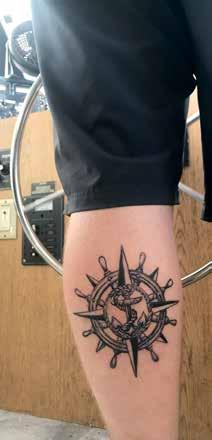
Colette Ruelette, a professional tattoo artist since 1993, has worked with many crew. “The stigma of tattoos has a reputation that clashes with this upper crust illusion of flawless perfection. Some people will never see tattooing as an art — nor the difference in the quality of work.”
Her crew clients often lean toward nautical or sentimental designs. “U.S. and British sailors popularized tattooing by the late 1800s, getting tattooed to mark their memories, travels, and accomplishments,” she said.
Crew today still choose designs that reflect their love of the sea or honor their homeland. “It’s a memento or possession they can keep on board in their tiny living quarters. Designs usually involve their accomplishments, or passion for the seas.”
In recent years, she’s noticed yachties getting highly visible tattoo art — a shift from when ink was hidden. “Now as long as they keep it classy, it’s becoming more popular and acceptable in such an elite industry.”
Even as acceptance grows, placement still counts.
“If you have a tattoo on your face or neck, it definitely shows less high-class standards than a nice underwater/nautical themed tattoo on your arm or leg that can be easily concealed,” Hansen said.
“Easily covered tattoos, especially ones covered in short-sleeve uniforms, will lead to more opportunity in yachting,” Pisut said. “‘Appropriate’ tattoos can also make finding jobs easier — obscene images or language will lead to a negative outlook on a candidate.” ‹

“Now as long as they keep it classy, it’s becoming more popular and acceptable in such an elite industry.”
–Colette Ruelette

By Lauren Beck

“I believe that it would probably be the most beneficial to earn the benefits by proving oneself first. Typically, salary is negotiated upwards after a successful trial.”
– Don Mckee
It might seem like paperwork is a heavy burden in yachting, but it can also serve as protection on the job. At the very least, crew should have an employment contract before they step foot on a yacht or start a new job.
There are protections for crewmembers under the Maritime Labour Convention (MLC), which establishes international standards for crew welfare. It requires that all crewmembers covered by the MLC have a Seafarer’s Employment Agreement (SEA). However, not all countries, including the United States, are signatories to the MLC, and private vessels are also excluded. Still, there are other protections through U.S. maritime regulations. Your employment contract is your first defense.
Nevertheless, most of the crew agents noted that they generally know crewmembers who work without a contract.
“You would think it would be standard by now,” said Marcy Williams, director of crew placement at Northrop & Johnson in Fort Lauderdale. “Most boats will have a SEA in place, but some still do not. In my opinion, those boats are not professionally run, and I would be very careful as you, as a crewmember, are not protected.”
At its core, the contract outlines your job duties and compensation. Be cautious about starting a new job based solely on a handshake or personal connection. If something goes wrong and the terms of your employment are not in writing, you may end up stranded without repatriation or have a harder time getting your final pay.
“Get [the contract] in hand before you join the boat — there’s nothing worse than joining a boat, and they go, ‘Oh, you’re on 5,000, not 6,000.’ And you’ve got nothing to [prove otherwise]. It’s just common sense,” said Liam Dobbin, managing director of Wilson Halligan. He deals with both private and MLC vessels, and he noted that those under the private banner offer a “variation of an MLC contract,” while also acknowledging that it’s not unheard of for some boats to work off a handshake or an email. However, it’s just a complication crew don’t need if something goes wrong.
“Sadly, yes, I have spoken with a few crew who asked for advice about what to do when they are not being offered contracts,” said Don Mckee, cofounder and director of YOA Yacht Crew. It’s up to the crewmember to ask for one and advocate as much as possible for themselves. Make sure that all employment details are documented in writing and outlined in the contract.
Once you have a contract, review it carefully. This may sound like common sense, but Mckee shared that many crewmembers over the years have told him that they never actually read their contracts. Don’t do this — crew need to know that the terms they were promised are the terms actually included in the contract.
Know your entitlements and responsibilities. McKee recommends that crew check whether the leave, salary — including how and when it will be paid — and benefits are listed, what the repatriation conditions are, and what the medical entitlements are. He also advises
checking all the basics, like whether the boat name on the document matches the boat you interviewed for. For that matter, make sure your name and all your personal details are correct.
Williams also advises new crew to do their research to ensure they’re familiar with the industry standards for the position they’re applying for. “If the salary is exceptionally low, there is a reason for that, and I would be wary,” she said.
While salary and benefit negotiation ashore is usually expected when it comes to job contracts, green crew just starting in the yachting industry may find there’s not a lot of wiggle room on yachting terms. New crew don’t typically have a lot of leeway, said Lauren Cotton, president of Cotton Crews — unless you have a skill or license the boat really needs.
McKee agrees that perhaps negotiation is possible in some cases, but “I believe that it would probably be the most beneficial to earn the benefits by proving oneself first. Typically, salary is negotiated upwards after a successful trial.”
At the end of the day, crew only hurt themselves if they don’t have a contract. At a minimum, every crewmember should have a basic one. If any program seems reluctant to provide a contract, it’s probably a red flag. On the bright side, Dobbin has noticed a trend among the younger generation of crew. He notes that these younger workers prefer their “documentation, compliance, regulations, and all the boxes ticked,” so perhaps that shift is starting. ‹

By Gemma Harris
In an industry of adventure seekers, most crew start without much thought about life after yachting. The typical plan of “I’ll do a few seasons, save up, and travel,” leaves the reality of exiting both liberating and terrifying. The truth is, returning to land life is tougher than many admit. Triton spoke to former crew who made the jump to shore to share what it’s really like.
LOOSEN THE “GOLDEN HANDCUFFS” SLOWLY BUT WISELY If you joined the yachting industry for adventure, chances are it was the salary that kept you in longer. There’s a reason it’s called the “golden handcuffs,” and it isn’t just the paychecks; everything on board is provided. You can go years without buying a single tube of toothpaste.
“Don’t be afraid to do it. I was so scared to tell people I didn’t want to become a chief officer because the only route to success or the top is becoming a captain. Says who? Own it and run with it,” said Liberty Nogueira, former bosun and founder of OnDeck.
When you eventually finish, all the costs of everyday life hit, especially in a world where prices are rising. Former crew emphasize the importance of preparing financially, well before leaving.
Depending on your career move, you may need to start at the lower end of the salary band. If you want to start a new venture or pursue further education, this means investing. The advice? Build up a financial cushion before you leave.

It’s not so much about what you’re going to do but where you’re going to do it. When your passport stops filling with stamps, you leave behind a home that constantly moves, with friends and family scattered everywhere. The idea of settling can feel overwhelming.
Some crewmembers head back to their home countries, while others move to places they spent time in along the way. Choosing a location is more than just personal preference. There are logistics to consider, such as residency permits, visa requirements, and tax implications, which influence where you live and work next.
Another challenge is the potential lack of social life. On board, you live and work with the same people 24/7, and leaving this can feel isolating.
Former crew often talk about the contrast between living spontaneously and the reality of planning activities weeks in advance on land. Most recommend finding a local support system, whether that’s joining a sports
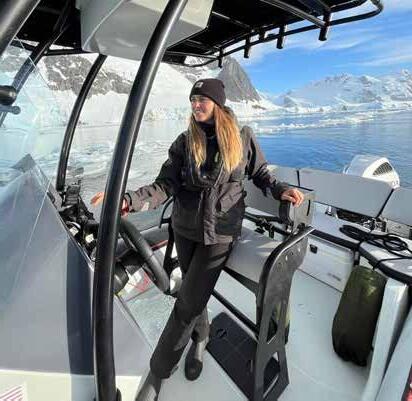
club, reconnecting with old friends, or beginning a new hobby.
“Be gentle with yourself! I still feel strange on land, but the routine, and being around non-yacht people, is starting to feel more relaxing instead of feeling out of place like I used to,” said Ciara Farrow, former chief stew/purser and founder of SevenStar.
As much as you may crave your own space, being able to attend family events, or watching Netflix on the sofa, don’t underestimate how much you will miss the yachting lifestyle. Spontaneous days off, beach barbecues, exploring a new city, and watersports on tap aren’t so easy on land. Working hard and playing harder is the essence of being crew, and replicating that on land isn’t as simple.
However, with time, new hobbies, and a healthier work-life balance, many former crewmembers say they have learned to embrace the different pace of life on land and find joy in the routine, even in the “normal,” everyday aspects.
“The slower pace is hard to get used
to, but in the long term, you will thank yourself for investing in yourself and your future. The same drive that served you at sea will carry you far in business,” said Kate Teare, former stew and founder of Studio Voyage.
It’s okay if you don’t have a plan A when it comes to life ashore.
“Release the pressure of ‘leaving for good,’ or feeling like a failure if you want to come back. Maybe you just need a break,” said Madison Jay Brauer, chief stew and founder of Shore to Sea.
If you’re considering stepping away from yachting, now’s the time to explore what life ashore could look like. Every ex-yachtie emphasizes the value of research, upskilling, and connecting with those who have already been through this experience.
Most importantly, be kind and patient with yourself, build financial stability, and create a plan to help ease the adjustments. Leaving yachting isn’t an end, it’s just the start of your next adventure. ‹


BY LAUREN BECK

A conversation with her financial advisor husband nudged Cherise Reedman onto a new career path: helping women transition ashore and find their footing outside the yachting industry. The company hosts events and has grown to include a podcast where women share their stories and insights.
I started yachting [13] years ago. I’d already been traveling for a long time — I was in Australia for a while, then New Zealand, and yachting was mentioned to me. I didn’t want to go home, but I didn’t know what to do next. At the time, I was working for a law firm in New Zealand, and I started doing some research — I thought it could be quite cool. I can serve rich people drinks and food — easy — and get back over to Europe because my family is all in the U.K. I did my STCW in Australia, and then went over to Europe, stayed in Antibes, did the crew house, and then got my first job on board.
WAS IT CHALLENGING MOVING ASHORE?
By 2016, I was already out of yachting. I’d met my husband-to-be and decided that I could keep going, but I had lost different relationships because it’s hard to maintain a relationship and travel so much. While I was on board, I did loads of research [into becoming a masseuse]. I thought I knew what I wanted to be, bought loads of courses, and spent thousands thinking that I had cracked it and only wanted to be on land, but I underestimated it massively and wasted a bunch of money. I should have tried it out first before committing to that career, because I got really overwhelmed really
quickly. New relationship, new location, new career, no money, pressures. Like all ladies that leave, it just gets very overwhelming, very fast, and then you bounce back. That’s where the golden handcuffs comment comes from.
My husband works in finance and has been trying to prevent yachties from making bad investments. He wanted to write an article about why I ignored his financial advice. I asked him, Why do you just want to do it about me? So I put a call out. We arranged a lunch with ladies who were still on board and ladies who had left the industry. We talked about female finance. Afterward, we opened the floor up to talk about the female experience in yachting and why I wasn’t the only one ignoring financial advice.
I thought, this is good. Why doesn’t anybody else do this? Why didn’t they open the floor and have meaningful conversations about what is going on with women in the industry? After that, we organized a few similar events. We had guest speakers who inspired and informed women at whatever stage, whether they were building a business or figuring out what they wanted to do afterward, and they went down really well.
In its simplest form, it’s about women looking out for women and feeding the knowledge and information, like pearls of wisdom, back to the next generation of women. The challenge is, how do you get the information back so it doesn’t sound like a lecture?
You’ll talk about scenarios of your life, tell a story, and a woman will listen to that story and then remember that story when she’s in that situation, and pull out the wisdom or how you rectified that decision. I could stand up and lecture people about how to live their lives, but there’s no hook, there’s no way to make sure they retain it.
So Pearls of Wisdom started with events [with speakers who would share their stories]. Now we’ve got the podcast, which has made it easier because now we have the time, space, and even the means to get in there. It’s called Tales from the Superyacht Laundry.
It’s really going back to that fundamental connection that society is perhaps struggling with a little bit too. Women are going through a real turbulent time. I think we are the generation coming to terms with a lot of different things — we are the generation that [embraces] feminism, but we still want to be mothers,

and we still want to have careers. We need to figure out how to have a more harmonious balance of all those things.
We’re sharing knowledge and offering support. We’ve now got an app with resources on trusted individuals, and we’re putting together a resource pack to give women guidance, because leaving the industry is very, very difficult, mainly because of the isolation. You go from an environment where your boat and your industry are all wrapped around you, and you don’t need to work for friends or find people to connect with, to complete isolation if you’re not careful.
That is hard for any woman — you’re moving to what could be a foreign country. You’re changing your relationship status from 24/7 to long distance. You’ve got to reinvent your career and what your purpose in life is, and then perhaps have a baby as well. So, you’re trying to do all these things, all at the same time, all those massive things that a lady on land would do one at a time.
The power dynamic on board is always out of our favor because the lifespan of a female on board generally is that she leaves because she’s either having a kid, or her looks have gone, or she has come to the end of it. So Pearls of Wisdom is the information that needs to get back to the women on board, because they will encounter the same vulnerabilities. They will encounter the same problems.
Women need to, again, be more informed if a situation arises. That’s why I want them to be able to access Pearls to have that resource, so they don’t have to try to navigate these situations alone. The information from the ladies who have left yachting is not going back — like lemmings, we’re just following each other off the cliff, and making the same mistake over and over. With the right encouragement, with the right

information, [moving ashore] can be the perfect step into your dream job, career, or next chapter.
You have to be flexible, because this is a moment when you can recreate yourself. The hardest thing is really tapping into who you are underneath. You come from a very rigid environment where you don’t really get to express yourself truly, only to then have carte blanche to go nuts. I thought I was quite a naturally organized person, but it turns out I’m not. I just thrived in a highly organized environment. I had to learn to organize myself. You just need to go with the flow and try not to stress yourself too much.
You will run out of money. It’s inevitable, but you’re not alone. There are loads of ladies who have done it. You don’t have to start your own business either. Many of these ladies come from team environments, and unless you’ve got a true calling, reach out to women who have created a business afterward. They’d hire ex-crew in a heartbeat because they know your work ethic. It can be daunting

to set up your own business. Take it one day at a time, one challenge at a time — it’s a marathon, not a sprint.
WHAT’S NEXT FOR YOUR COMPANY?
Hopefully, we’ll announce a new partnership with the podcast. We’ve already partnered with institutions like Nautilus, ISWAN, CrewPass and a few others because we promote getting proper support from qualified people.
We also started Balls of Wisdom, a mini-series within the podcast with six bonus episodes, to provide a male perspective on crew-related topics, but still keep the content authentic.
We are also planning a project for the Monaco Yacht Show involving the Crew Wellness Bags. The main point of the bag this year is to raise awareness of the YachtCrewHelp line from ISWAN. We plan to distribute 250 unisex bags at the show, including coordinating with various companies like Seas the Mind, MHG, Superyacht Fitness, and CrewPass, to provide relevant resources and information for crew.
I just want to try and help people as much as I can. ‹
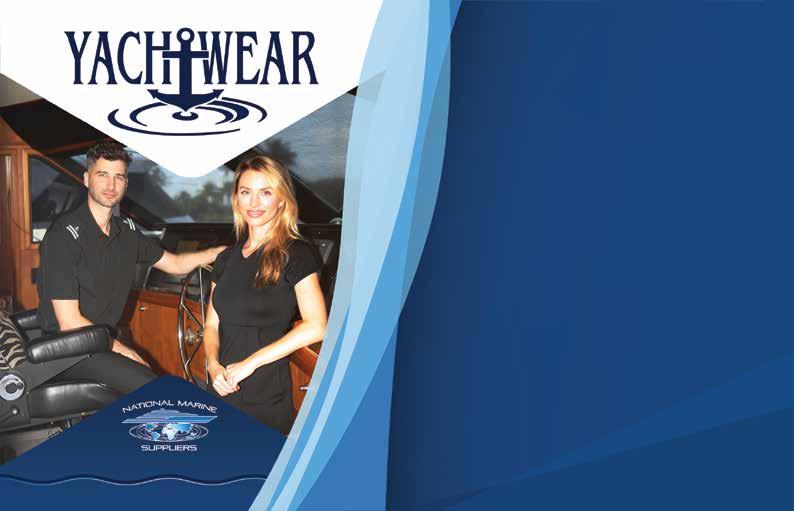
















By Rebecca Taylor
From the outside, moving into brokerage makes sense. Crew know yachts from the inside out, have experience with ultra high-net-worth individuals (UHNWI), and bring firsthand understanding of the service and operational standards clients expect.
For many professional yacht crewmembers, the decision to leave life at sea isn’t the end of their maritime journey — it’s just a change of course. One of the most common transitions is from crew to yacht broker, a move that might seem like a natural next step. After all, who better to sell or charter yachts than someone who has lived and breathed life aboard?

But does this transition really work? Is onboard experience enough to succeed in the high-pressure world of yacht sales? And what do those who’ve made the leap wish they’d known before making that transition to life on land?
We spoke with Tristan Mortlock, former superyacht captain and now director of Mortlock Yachts, about his own transition and whether brokerage life lives up to expectations.
“Having run yachts, you understand the operational realities – layouts, crewing needs, running costs, even the limitations of design,” Mortlock said. “That kind of insight builds instant credibility with buyers and charter clients alike.”
Beyond technical knowledge, former crew are often well-versed in the interpersonal dynamics required to succeed in a client-facing business. Mortlock points out that years of catering to UHNWI guests on board help hone emotional intelligence –reading personalities, anticipating needs, and maintaining professionalism under pressure.
Add to that a global network developed over the years at sea – owners, captains, shipyards, surveyors – and you’ve got the foundation for a serious career in sales.
The move isn’t without growing pains.
“The transition from a stable salary to


full commission is a big one,” Mortlock said. “You need discipline, savings, and patience, especially in the early days when deals are few and far between.”
Another surprise for many new brokers is just how complex the business side can be. Learning contracts, VAT law, charter management structures, and CRM systems is often a steep learning curve for those used to the structured world of onboard life. And then there’s the emotional rollercoaster.
“Deals fall apart. Clients ghost you. Months go by without a paycheck. It can be heartbreaking if you’re not mentally prepared,” Mortlock said.
Despite the challenges, many former crewmembers find brokerage incredibly rewarding – especially those with an entrepreneurial mindset.
“You control your time, your business, your brand. The earning potential is unlimited, and every deal is a new puzzle to solve,” Mortlock said.
For those who still love the yachting lifestyle but want more stability or freedom, brokerage offers a unique blend. Travel remains part of the job – boat shows, viewings, and client visits keep things dynamic – without the 24/7 operational stress of life on board.
“You’re still deeply connected to the superyacht world, but with more personal freedom,” Mortlock said.
“Having run yachts, you understand the operational realities – layouts, crewing needs, running costs, even the limitations of design.”
– Tristan Mortlock
Lessons from the Journey
Looking back, Mortlock says there are a few things he would do differently if starting over.
“I would’ve started building a proper database from day one – keeping track of every contact, lead, or conversation. That’s invaluable long-term,” he said. “And I wish I had shadowed experienced brokers early on. Watching how deals unfold in real time accelerates learning.”
He also emphasizes the importance of qualifying clients. “Spending time upfront to understand if a client is serious helps you avoid wasting time with ‘fender kickers.’”
That said, there are key choices he wouldn’t change.
“I leaned into my experience as a captain – that was always my strongest selling point. And we’ve stayed clientfocused, treating everyone with the same service mindset we had on board.”
Interestingly, Mortlock credits his Super Yacht Captain YouTube channel as one of the most powerful tools for building visibility and credibility.
“It’s where the majority of our clients discovered us. Content builds trust.”
So, is becoming a broker the right move for former crew?
The answer depends largely on mindset and long-term goals. Transitioning from a structured team environment to a self-directed sales role requires resilience, adaptability, and a strong entrepreneurial spirit. Success in brokerage isn’t guaranteed – but for those who combine deep industry knowledge with relationship-building skills and a willingness to learn about the business side, it can be a highly rewarding path.
With the right preparation and persistence, moving from sea to sales can offer a fresh chapter in the yachting world – one that keeps you close to the industry you know, while opening doors to new challenges and opportunities. ‹
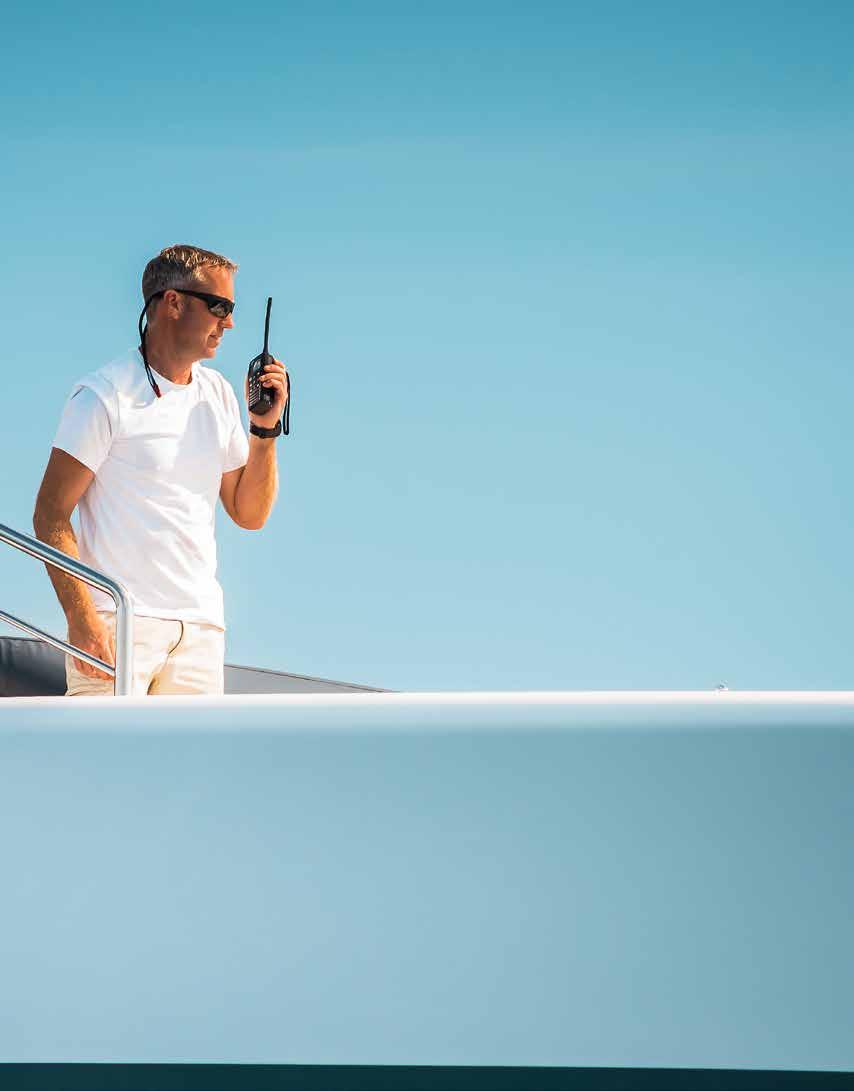
By Patricia Clark
Working on a yacht can be exciting, but it’s also relentless — and with age, that can take a toll. For those in their 40s or 50s, it’s not just about being tired or “getting older,” it’s about whether your body, mind, and life outside of yachting still fit inside the job’s intense demands. At a certain point, 18-hour days and long stints at sea don’t just exhaust you — they conflict with the rest of your life. Mental fatigue builds over time. Long-term crew often deal with stress, anxiety, and isolation that no amount of sun or scenery can fix. In a space where privacy is non-existent, personal downtime is limited, and the pressure to always perform is nonstop, it’s easy to feel boxed in. Add in the generational gap and it can start to feel like you’re on the outside of the crew community while living among them.
Then there’s the physical reality. Yachting demands constant movement, fast thinking, and physical strength. Lifting heavy provisions, navigating narrow stairs, responding to guest needs at full tilt — it all hits differently in midlife than it did in your 20s. Recovery time stretches, small injuries linger, and eventually, your body starts asking questions your contract doesn’t answer.
Personal life becomes harder to ignore, too. Parents may need support, or you may feel the weight of a partner or child who’s always on the other end of a video call when the Wi-Fi actually works. Shore-based side projects or businesses get neglected. It’s not always burnout — it’s that life off the boat grows louder, more complex, and more important.
Then there’s the financial side. While yacht salaries can be excellent, especially early on, they come with complications. Tax obligations differ wildly depending on where you’re from and how long you’re offshore. U.S. crew must often navigate international income reporting, while South Africans and U.K. nationals face their own rules and thresholds. On top of that, proving income for things like mortgages or loans becomes a real challenge — banks want to see structured tax documents, not just wire transfers from a management company.
Insurance is another pressure point. Mental health coverage is often minimal, and medical or life insurance isn’t always offered by the boat. Many crew don’t start thinking about personal coverage or long-term savings until well into their 30s or 40s, when rates are higher and options are more limited. Those who stay in the game longterm usually have a financial advisor helping them build structure around unpredictable earnings.
Leaving yachting doesn’t have to be dramatic. For many, it’s a shift — not a crash. You can use what you’ve learned to step into consulting, shoreside hospitality, or training roles, but it helps to prepare early: build savings, track earnings, sort out insurance, and look realistically at when the boat no longer matches the life you want.
Eventually, it’s not about whether you can do the job. It’s about whether the job still fits the life you’re building. There’s nothing wrong with making that decision on your own terms. ‹


BY WESLEY WALTON
The yachting industry is often perceived as glitzy, glamorous, and filled with exotic locations and exclusive adventures. So why wouldn’t you aspire to a lifelong career at sea?
After discussions with individuals around yachting, it has become evident that this perception is largely a highlight reel. While crew undoubtedly experience once-in-a-lifetime moments on the job, it’s crucial to consider the costs associated with such a lifestyle and whether it’s sustainable as a long-term career.
In recent years, the notion that yachting is “a young man’s sport” has
gained traction. There are many benefits to this line of work: travel opportunities outside your comfort zone, forming friendships with diverse individuals, a decent salary with minimal living expenses, a strong work ethic, and polished interpersonal skills. Yet, what sacrifices lie beneath the surface and why is this lifestyle now being referred to as “a young man’s sport?”
Committing to a life at sea often means forfeiting significant personal experiences. Many crewmembers miss vital moments like Christmas celebrations with family, the weddings
of close friends, and the gradual aging of their parents. As time goes by, they may find themselves increasingly distanced from witnessing their children’s milestones and everyday joys — never mind the pressures that your absence at home might have.
“My biggest regret is missing the funerals of some of my family members; however, I love my job and even though I am away from my family for half the year, I know when I am home, I am fully present for that other half of the year with no distractions,” said Chief Engineer Christian Lawson-Mckittrick, who has
been in the industry for 35 years.
“I can’t see yachting as a life-long career anymore as my greatest regret has been not being present with my parents as they aged,” said Chief Officer Michael Whelan, who has spent 10 years at sea. “This has motivated me to cherish every moment I can spend with my own family, ensuring I don’t miss out on those precious little experiences.”
This leads to a pressing question: is this lifestyle worth it if you can only spend half your life with a spouse, children, and cherished friends? For many in the industry, the answer seems increasingly to be no. Conversations with current crew reveal a growing consensus that the sacrifices required are significant, prompting many to reevaluate their priorities. Many current crewmembers are now placing a higher value on time spent at home and are developing exit

“THIS HAS MOTIVATED ME TO CHERISH EVERY MOMENT I CAN SPEND WITH MY OWN FAMILY, ENSURING I DON’T MISS OUT ON THOSE PRECIOUS LITTLE EXPERIENCES.”
—CHIEF OFFICER MICHAEL WHELAN
strategies that will enable them to transition to land-based careers, leaving life at sea behind.
Ultimately, you must consider whether the luxury of a life at sea is worth the personal trade-offs. While the yachting industry may offer a captivating lifestyle filled with adventure, the realities of working at sea present challenges that many choose to reassess as they contemplate their long-term happiness. The draw of the industry must be weighed against the invaluable experiences that create lasting bonds with loved ones. As the yachting industry continues to evolve, crewmembers are increasingly compelled to find a balance between their passion for the sea and their commitment to the life they want to build at home. However, the question we should all be asking ourselves is: does this balance exist? ‹
CHIEF OFFICER WESLEY WALTON HAS BEEN IN YACHTING FOR 12 YEARS. HE HOLDS A MASTER 3000GT LICENSE WITH VAST EXPERIENCE ON HIGH-PROFILE CHARTER BOATS.


•



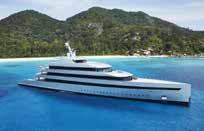



THE ISLAND NATION IN THE MEDITERRANEAN MIGHT BE SMALLER THAN OTHER YACHTING DESTINATIONS, BUT ITS HISTORIC SITES, ACTIVITIES FOR CREW, AND TOP MARINAS MATCH UP WITH ANY YACHTING HUB.
By Kevin Maher











he Mediterranean archipelago of Malta defies expectations. It might be small, but with a rich history dating back thousands of years, Malta offers worldrenowned UNESCO World Heritage sites, elite Mediterranean cuisine options, beach hopping, nightlife, and wellness retreats. Malta’s capital city, Valletta, was built by the Knights of St. John and is home to hundreds of monuments, making it one of the most densely concentrated historic areas in the world. Captains and crew visiting Mdina in Malta might also recognize it as the fictional city of King’s Landing in “Game of Thrones” — just one example of Malta on the big screen, with others including “Gladiator I” and II, “The Count of Monte Cristo,” “Jurassic World Dominion,” “Napoleon,” and “Popeye.” From a history rich with culture — both real and fictional — to toprated gastronomy and glassy beaches, Malta has something for every yachtie.


Surrounded by fortress walls, the trio of fortified cities across the harbor from Valletta are woven together by history, architecture, and culture. Not only are the three cities connected geographically, but they played a key role during the Great Siege of 1565 and World War II. The Maltese Islands were subjected to more than 3,000 air raids after becoming a base for Allied forces during WWII, but the cities stayed strong and continue to thrive.
You’ll notice a recurring theme as you walk through Vittoriosa’s quaint alleys, which snake around the city — a focus on history. If you’re in the business to learn more about Malta’s historic significance, don’t miss Vittoriosa’s offerings. You’ll want to start with Fort St Angelo, a fortress dominating Grand Harbour that dates to 1274. It played a major role in the Great Siege of 1565 and suffered 69 direct hits during WWII. Visitors can explore the fort’s various architectural styles, see examples of artillery used throughout the years, and enjoy views of Malta.
The Roman Inquisition dominated Malta for more than 224 years. During
that time, the inquisition repurposed The Inquisitor’s Palace to house a tribunal. While the Inquisition was abolished by the French upon their arrival in 1798, the palace remains, serving as both a historic house museum and the national ethnography museum. Visitors can take a stroll through Malta’s religious and political history while visiting the palace.
Finally, Vittoriosa gives maritime historians a gem to discover. Malta’s Maritime Museum is located blocks away from The Inquisitor’s Palace and stands as a testament to Malta’s maritime and naval legacy. Artifacts, ship models, and historical documents spanning Malta’s history can be found here.
Like Vittoriosa, Senglea offers visitors a glimpse into Malta’s past. The Gardjola Gardens offers panoramic views of Marsa, Valletta, Grand Harbour, and Fort St Angelo through Malta’s iconic ancient guard tower. The views and garden make for a perfect crew picture. Although Senglea is smaller, it has a few dining gems located on the water. Il-Hnejja offers Italian and seafood dishes, while

Closing out Malta’s three cities, one of the country’s main attractions is the Collegiate Church of the Immaculate Conception in Cospicua. Dating back to the early 16th century, the Roman Catholic parish church includes art by Giuseppe Cali, Abram Gatt, and Pietro Paolo Caruana while boasting impressive interior architecture. The church is often considered a miracle after it survived bombing during WWII. Walking through Cospicua is recommended, especially through the Cotterna Lines — massive fortifications built by the Knights of St. John — and the Dockyard Creek Waterfront, which was once Malta’s naval and industrial heart. Art and sculptures have also been embraced throughout the city, so be on the lookout for public displays.


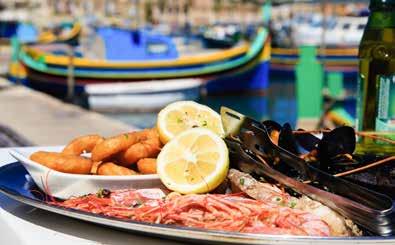

Created due to a sporting rivalry between two British yachtsmen in 1968, the Rolex Middle Sea Race is still centered in Malta and will celebrate its 57th anniversary on October 18th. This 606-nautical mile course starts and finishes in Valetta’s Grand Harbour, but travels around Sicily’s coastline, through the Strait of Messina, and around the remote islands of Pantelleria and Lampedusa.
The race has been title-sponsored by Swiss watchmaker Rolex since 2001, stamping itself as a globally recognized sailing event. Boats in a variety of classes compete for victory in the IRC/ORC handicap-style race, but the event is not just about who wins. Mediterranean culture, the island’s vibrant history, warm hospitality, and delicious food is on full display, turning this race into an event to attend even if you’re not racing.
A destination fit for yacht crew doesn’t work without marinas that reach crew standards. Fortunately, Malta’s marinas offer elite amenities that crew can enjoy while being close to all the action Malta offers.
Just a 10-minute drive from Malta International Airport and 15 nautical miles from Malta’s coves and bays is Marina di Valletta. With more than 280 berths available for yachts up to 28 meters and superyachts up to 75 meters, the marina is a fit for most yachts traveling in the Med. Marina personnel and security are on site at all hours, while yacht cleaning and loading/unloading support services are available as well. Crew looking for Mediterranean cuisine close to home should consider SAMIZU Restaurant at the heart of the marina.
marinadivalletta.com
Originally built in 1962 by British and Maltese engineers, Gardens Yacht Marina is located deep inside Lazaretto creek in Marsamxett Harbour. Up to 126 berths are available for yachts up to 60 meters, with a plethora of Malta’s yacht chandlers, brokers, and service providers located within a three-minute walk from the marina. Electricity up to 400 volts, laundry services, yacht repair and maintenance services, and a tank pump out facility are available at the marina.
gardensyachtmarina.com

Grand Harbour Marina is located in Vittoriosa, across the harbor from Malta’s capital. With 26 superyacht berths for yachts up to 135 meters, Grand Harbour Marina can accommodate captains and crew throughout the year. Provisioning and concierge services are available, while one of Europe’s leading shipyards, Palumbo, is next door, making it a sought-after hub for refit and maintenance services. Electricity up to 400 volts, gray- and blackwater discharge, fuel bunkering, 24-hour security, and Wi-Fi access throughout the marina are just some of the amenities Grand Harbour Marina offers. Yachties can also enjoy a busy captains and crew club, which includes activities like yoga, gokarting, and barbecues.
ghm.com.mt
Centrally located in Gzira, Manoel Island Yacht Marina can accommodate vessels up to 100 meters in length in its 220 berths. Mooring is “Mediterranean style,” where the marina provides bowlines while stern lines must be provided by the vessel. Electricity, fueling services, and overnight security are available. The marina offers refit services at its nearby Manoel Island Yacht Yard, which is situated close to cafes, bars, and nightclubs while offering crew offices onsite.
miym.com.mt


Aug. 1 & 2
Shania Twain
HOLLYWOOD, FLORIDA
At the Seminole Hard Rock Hotel & Casino at 7:30 p.m. seminolehardrockhollywood.com
Aug. 1–3
Newport Jazz Festival
NEWPORT, RHODE ISLAND
The 71st annual jazz festival returns with a huge lineup of jazz artists.
newportjazz.org
Aug. 1–3
Seafair Weekend Festival
SEATTLE, WASHINGTON
Mark your calendars for the weekend festival, which includes the Boeing Seafair Air Show with an appearance by the U.S. Navy’s Blue Angels, the Apollo Mechanical Cup Hydroplane Races, Dick’s Drive-In Classic Car Show, and a festival. seafair.org
Aug. 1 – Sept. 30
Dine Out Lauderdale
FORT LAUDERDALE, FLORIDA

Aug. 8–17
Monterey Car Week
MONTEREY, CALIFORNIA
Monterey Car Week is an annual celebration of automotive excellence, showcasing classic cars, luxury vehicles, vintage racing, and events like the Pebble Beach Concours and RM Sotheby’s Auction. seemonterey.com

Aug. 14–17
Sydney International Boat Show
SYDNEY, AUSTRALIA
The show takes place under one roof at the Sydney Showground, Sydney Olympic Park, and includes everything from tow sports and fishing to marine tech and accessories.
Aug. 24 – Sept. 1
Burning Man
BLACK ROCK CITY, NEVADA
Thousands gather in Nevada for this annual festival celebrating community, art, self-expression, and self-reliance. The 2025 theme is Burning Man 2025: Tomorrow Today. burningman.org
Aug. 26–29
The South Pacific Superyacht Rendezvous FIJI
An extension of The Superyacht Gathering, the Rendezvous launched in 2024 to gather the sailing community and showcase the islands. The event includes racing with shoreside experiences. thesouthpacificsuperyacht rendezvous.com
Aug. 27 – Sept. 6
July 30 – Aug. 3
Maine Lobster Festival
ROCKLAND, MAINE
This five-day festival attracts thousands to enjoy fresh, local lobster, a seafood cooking contest, children’s events, parades, a dog show, a fun run, and more. mainelobsterfestival.com
July 31 – Aug. 3
Lollapalooza
CHICAGO, ILLINOIS
This four-day music festival draws thousands of music lovers for a diverse lineup of musicians, including rock, hip-hop, and EDM. lollapalooza.com
Looking to try new restaurants in the Fort Lauderdale area? Dine Out Lauderdale allows local restaurants to offer food, cocktails, and more through their special three-course dinner menus for $35 or $45 during the event.
visitlauderdale.com/dineout

sydneyboatshow.com.au
Aug. 15 & 16
Gabriel Iglesias
HOLLYWOOD, FLORIDA
At the Seminole Hard Rock Hotel & Casino at 8 p.m. seminolehardrockhollywood.com
Aug. 17
Pebble Beach Concours d’Elegance
PEBBLE BEACH, CALIFORNIA
Widely regarded as one of the world’s premier car shows, the event showcases an impressive array of vehicles, from vintage classics to iconic supercars. Attendees can also enjoy a Gourmet Picnic on the 18th fairway.
pebblebeachconcours.net
Venice International Film Festival VENICE, ITALY
The 82nd Film Festival is back, dedicated to raising awareness and celebrating international cinema in all its forms — art, entertainment, and industry. labiennale.org
Aug. 28
Blink-182 & Alkaline Trio HOLLYWOOD, FLORIDA
At the Seminole Hard Rock Hotel & Casino at 7 p.m.
seminolehardrockhollywood.com
Aug. 29
Def Leppard
HOLLYWOOD, FLORIDA
At the Seminole Hard Rock Hotel & Casino at 8 p.m.
seminolehardrockhollywood.com
Aug. 31 — Sept. 3
Lady Gaga
Miami, Florida
At the Kaseya Center at 8 p.m.
Sept. 4
NFL Kickoff
PHILADELPHIA, PENNSYLVANIA
The defending Super Bowl champions, The Philadelphia Eagles, will host the Dallas Cowboys to start the 2025 NFL season. nfl.com
Sept. 9–14
Cannes Yachting Festival
CANNES, FRANCE
Nearly 700 boats, ranging from 5 to 50 meters, make their way to the heart of the French Riviera for the show that hosts more than 55,000 visitors. cannesyachtingfestival.com
Sept. 10
Triton Fall Expo
FORT LAUDERDALE, FLORIDA
This year's Fall Triton Expo will take place at National Marine Suppliers, 2800 SW 2nd Ave, Fort Lauderdale, FL 33315.
For sponsorship information, contact Flavia Patino-Paul at 786-760-0347 or email flavia@tritonnews.com. the-triton.com/events


Sept. 11–14
Newport International Boat Show
NEWPORT RHODE ISLAND
More than 17 acres of Newport’s historic downtown turns into a yachting hub as NIBS returns. newportboatshow.com
Sept. 11–14
The Safe Harbor Newport Brokerage Boat Show
NEWPORT, RHODE ISLAND
More than 50 sail and power yachts ranging from 26 to 124 feet are presented concurrently with the Newport International Boat Show. newportbrokerageboatshow.com

Sept. 18–21
Ibiza JoySail
IBIZA AND FORMENTERA, SPAIN
The superyacht regatta welcomes large sailing yachts, skippers, and crew to race and enjoy its vibrant social scene. ibizajoysail.com
Sept. 18–23
Genoa International Boat Show
GENOA, ITALY
The historic city of Genoa hosts yachting enthusiasts, captains, and crew for the show’s 65th anniversary. salonenautico.com
Sept. 19–28
Southampton International Boat Show
MAYFLOWER PARK, SOUTHAMPTON
The biggest boat show in the United Kingdom returns for its 56th year.
southamptonboatshow.com
Sept. 20 — Oct. 5
Oktoberfest
MUNICH, GERMANY
Parades, music, food, and drink will take place over this worldfamous, two-week long festival. oktoberfest.de
Sept. 24–27
Monaco Yacht Show
PORT HERCULE, MONACO
The 34th anniversary of the show brings more than 120 superyachts and 560 exhibitors together for one of the industry’s biggest annual events. monacoyachtshow.com
Sept. 23–28
Ryder Cup
FARMINGDALE, NEW YORK
Golfers from the United States and Europe battle it out at the Bethpage Black Course. rydercup.com
Sept. 26 & 27
Dua Lipa
MIAMI, FLORIDA
At the Kaseya Center at 7:30 p.m. dualipa.com
Sept. 27 — Oct. 5
Les Voiles de Saint-Tropez
GULF OF SAINT-TROPEZ, FRANCE Classic and modern yachts will sail along the Mediterranean coast to compete in this historic regatta once more.
lesvoilesdesaint-tropez.fr
Sept. 29 — Oct. 1
CROYA Charter Show
SPLIT, CROATIA
The second edition of the CROYA Charter Show looks to build on the success of its inaugural edition.
croya.hr/cro-y-a-charter-show

The crew showed up, the beer was cold, and the vibes were unmatched during Triton’s crew night at LauderAle Brewery & Taproom!





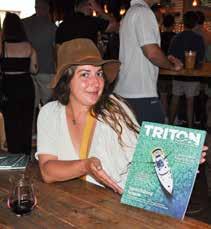


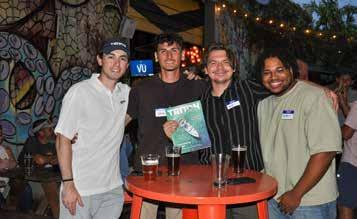






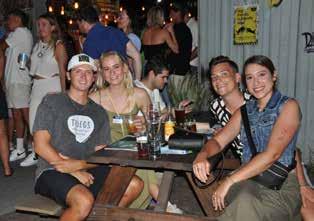
















Insured to Work in any Marina or Boatyard “WE
Underwater Yacht Maintenance Zincs, Monthly Cleaning, Propeller Removal Recovery of Lost Items, Inspections, Commercial Diving
(954) 964-4804 • email: mrsgdiving@gmail.com www.mrsdiving.com
Anita Warwick
Tel: +1 954 763 9787
M/WhatsApp: +1 954 294 2078
Skype: ozanita
Anita@SevenSeasHealth.com SevenSeasHealth.com



APPLICABLE WITH GAS/WATER SEPARATOR MUFFLERS
Process: Clean-Exhaust’s dosing pump injects the specifically formulated ecoBrew into the generator/engine raw water cooling system before the spray ring. The ecoBrew emulsifies the diesel particulate matter and soot as it passes through the piping and muffler, much like the agitation action in a washing machine. No back pressure is created in the process. Result: The exhaust gas is expelled with little or no particulate, facilitating cleaner air, cleaner harbors, cleaner oceans, cleaner hulls and boot stripes with no floating sheen or sludge.
One Captain, One Engineer, One Great Idea!... clean-exhaust
Captain Ted Sputh
Tel: +1 317-445-3873
Email: info@clean-exhaust.com
Rodger Stone
Tel: +1 518-378-6546
Email: res2itrmarine@gmail.com
www.clean-exhaust.com
Yacht-Mate Products
Tel: +1 954-527-0112
Email: sales@yachtmate.com



















Test your powers of observation! There are five things different in the second photo — can you find them?
Look for answers on Instagram @thetritonnews





